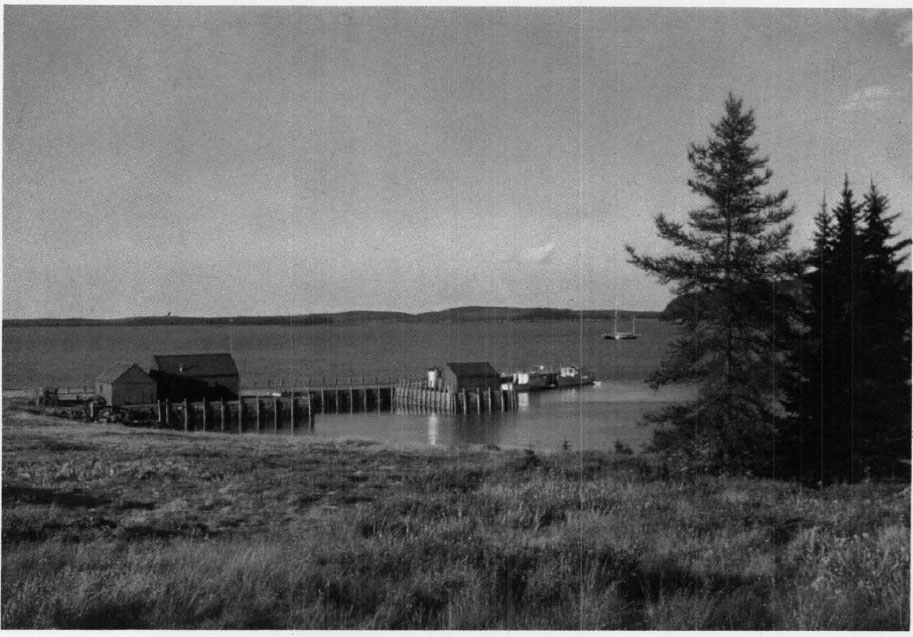December Meeting, 1955
A STATED Meeting of the Society was held at its House, No. 87 Mount Vernon Street, on Thursday, 22 December 1955, at three o’clock in the afternoon, the President, Hon. Robert Walcott, in the chair.
The records of the Annual Meeting in November were read and approved.
The Corresponding Secretary reported the receipt of letters from Mr. Mark Antony DeWolfe Howe accepting election to Honorary Membership; from Messrs. William Hall Best and William Bradford Osgood accepting election to Resident Membership; from Mr. Lawrence William Towner accepting election to Non-Resident Membership; and from Mr. Lester Jesse Cappon accepting election to Corresponding Membership in the Society.
Messrs. Myron Piper Gilmore and Perry Townsend Rathbone, of Cambridge, Walter MacIntosh Merrill, of Salem, and Charles Akers, of Quincy, were elected Resident Members, and Mr. Gilbert Stuart McClintock, of Wilkes-Barre, Pennsylvania, was elected a Corresponding Member of the Society.
On behalf of Dr. John Peabody Monks, a Resident Member, who was unable to be present on account of illness, the Editor read a paper entitled: “The History of Roque Island, Maine.” As Dr. Monks died on 3 March 1956, before completing the final form of the material that he wished to publish in this volume, the paper that follows has been edited by Diana Whitehill Laing [Mrs. C. Christopher Laing] from manuscripts and notes furnished the Society by Mrs. Monks. The Society is indebted to Mrs. Monks and to Dr. Monks’s brother, the Reverend George Gardner Monks, for gifts toward the expense of preparing the manuscript for publication and for illustrating it.
The History of Roque Island, Maine
“ISLANDS possess, of themselves,” Samuel A. Drake wrote, “a magnetism not vouchsafed to any spot of the mainland. In cutting loose from the continent a feeling of freedom is at once experienced that comes spontaneously, and abides no longer than you remain an islander. You are conscious, in again setting foot on the main shore, of a change, which no analysis, however subtle, will settle altogether to your liking. Upon islands the majesty and power of the ocean come to you, as in multiplying itself it pervades every fibre of your consciousness, gaining in vastness as you grow in knowledge of it. On islands it is always present—always roaring at your feet, or moaning at your back.”279 These lines, written about the New England coast, hold true for countless persons throughout the world who know and love islands. The present writer’s mind and heart are centered on a group of islands, of which Roque Island is the largest, lying on the northerly edge of the Gulf of Maine, near the mouth of the Bay of Fundy. They have been owned by members of the writer’s family for many years, Roque having been acquired in 1806 by his great-great-grandfather, Joseph Peabody of Salem.
The islands, in latitude 44° 34′ north, longitude 67° 31′ west, are roughly halfway between Mt. Desert and Grand Manan. Besides Roque there are, going counterclockwise, Little Spruce, Great Spruce, Double Shot, Anguilla, and Lakeman’s. They all lie in the middle of a coastal indentation, really one bay, but called on the east and north Englishman’s Bay, and on the west Chandler’s Bay. The usual contact with the mainland is at Roque Bluffs, three miles from the island wharf. The town of Jonesport is four miles away on Moosabec Beach, while seven miles distant from the wharf at Roque Bluffs is the Washington County seat, Machias. The best harbors for small vessels are Lakeman’s and in the Thoroughfare between Little and Great Spruce. Shorey’s Cove, though large, is also excellent.
The islands are completely wooded except for several open fields maintained on Roque. There are four houses, two barns and other smaller buildings, owned by the Roque Island Gardner Homestead Corporation, on the upper left-hand arm of the “H”-shaped Roque. One lobsterman has his “camp” on Patten’s Cove; there are eight others who camp on Lakeman’s Island. Roque’s most striking physical features are its mile-long, rocky and precipitous Great Head (formed like the head of a moose swimming through the water), and the mile-and-a-quarter-long crescent beach of white sand, which forms the under part of the crossbar, and part of the lower left-hand leg of Roque’s “H”.
The bare physical facts convey little of the enchantment of these islands; everyone who has visited or lived on Roque carries away his own set of sensations or incidents which most appeal to him. For one it will be the clarity of a brilliant day when water and sky are blue, clouds white, woods green, and the sand a sunny yellow-white. The sharp tang of a wind from the northwest cools the windward face, and each ripple on the water catches and reflects the sun. As the wind makes up and the sailboat increases her list and her speed through the water, little waves are born from the ripples, matching in the perfect whiteness of their breaking crests the underbody of the gull that with harsh cry wings by overhead.
For another it will be the complete freedom from the noise and bustle of urban civilization as he stretches, limbs still wet and tingling from a dip in the cold water, onto the white sun-warmed sand and gazes at the Great Beach, cumulus clouds floating overhead. And for another it will be the satisfaction of clearing with sharp-edged axe a path through a thicket of spruce so dense that a few years can hide a trail from all but those who first cut it. Or it may be watching the ever-present lobsterman from Lakeman’s hauling his traps attached to glass bottle floats and brilliantly painted wooden buoys. Or it may be the crackle as someone throws a green spruce branch on the hot evening picnic fire of guttering birchwood, while all around recline those whose stomachs are heavy with lobster meat. It may be threading the tree-encircled Thoroughfare, or Great Head at sunset, or a glimpse of a white-tailed deer in the depths of the woods; half-a-dozen seals basking on a tidal rock, or the clang-clang-clonk of the bells as the cows are brought in for milking. It may be the warning note booming every fifteen seconds from the lighthouse diaphone on Libby Island through the pall of graying fog that has crept in from the Nova Scotia shore, blotting out the moon and sending all indoors to a crackling fire. It could be any of these, or a hundred other sensations.
Rare indeed has been the visitor who did not completely succumb to the charms and beauties of Roque and its islands. As he steps onto the mainland, though he realizes he is no longer an islander, he will never forget Roque, and will always want to return. Those who have been able to do so year after year are fortunate. All of them know that Roque has become a part of them, and besides the pleasure it gives has had an influence in their lives for good. Nature, its beauties unspoiled—quiet, not absolute, but mixed with sounds of work and of pure joy—a return, if only partial, to more simple and uncomplicated life—all these are priceless island heritages to be cherished. The pages following attempt to recapture the facts of the past: the people, houses, fields, and vessels, the stories that are part of the history of these islands.
I
The visitor to Roque forgets the urgencies of time and place. He might be in another century, for he sees that there are lamps to trim, and pondcut ice is used for cooling; horses draw wagonloads of children to the beach. Yet there are also bathrooms, tractors, power saws and diesel engined boats. Bemused by his surrounding he asks about the Island landmarks; discovers there are several names for some of them, and hears the stories they inspire. About the best excursion that the newcomer makes is by boat, around the Island. In this chapter we shall also make the trip.
We travel in Spruce, a thirty-footer built on Jonesport lobster-boat lines with a small cabin, open cockpit, and powered with twin diesel engines. We start at the wharf in Shorey’s Cove and north around Squire’s Point. It was here that George A. Gardner erected a flagpole, from which he signaled for Allen Johnson and a boat during the first years at Roque; here also his son John would light bonfires to blaze good-bye to departing guests.
Rounding Squire’s Point, we enter the tidal current of Englishman’s Bay. Between Squire’s Point and Popplestone Point, four hundred yards westward, is a little indentation in the shore line in which there is little or no current. Here the lobster-pot buoys lie almost directly above their pots, rather than streaming out to the east or west as they do less than a hundred yards north. This indentation is actually the nearest point on the Island to the mouth of Chandler’s River, and anybody in a small vessel coming down the river from Jonesborough might land here if he could anchor safely. The evidence for this is a pile of large rocks which extend across the beach in a straight line, while at the top of the bank there is a line of stones extending a few yards into what was once an open field.
There is a story, dating from the decade before 1882, of two Italian brothers robbing a Boston bank, sailing a ship’s long boat down east and burying their loot on Henry’s Point in Mason’s Bay on the mainland. One of the brothers married a Henry girl, and three of them lived there for a time, but then returned to Boston where the married brother was killed. The surviving brother then returned and moved the loot over to Popplestone Point. He soon took a job with Herbert Long, caretaker of Roque, which lasted two years. Presumably storms, ice and tidal currents had removed the marks indicating where the loot was, and he was looking for them. After spending one night on Popplestone Point he abruptly left the Island next day, and the story goes that with the money he was able to buy a lucrative business out west. Meanwhile his widowed sister-in-law had come back and built a house near Mason’s Bay, and apparently spent most of her time digging on Henry’s Point where she believed some of the loot was still buried.
On the landward side of Popplestone Point is the ten-acre Back Field, which here adjoins the westerly part of the twenty-five-acre Home Field. Both these fields are now used for growing hay and farming; it was in Back Field that George A. Gardner closed the deal in 1882 with Gilbert Longfellow to buy back Roque.
If the tide is low we must shortly head out abruptly from the shore to avoid Roque Island bar, a ledge extending halfway across Chandler’s Bay to the mainland, and marked at its outer end by a red spar buoy. A black spar buoy marks the eastern extremity of a finger pointing from the mainland toward Popplestone Point, called Great Bar. The channel through Englishman’s and Chandler’s Bay passed between these two buoys.
Heading in toward the land again we see, at its edge, a red and white pump house, with masonry cistern beside it, which were built here to harness for household use the cold spring pouring out of the cliff house. This water supply has been much more reliable than that provided by the spring and pump a few hundred yards away on the top of the hill.
Parker’s Head makes a slight bulge in the shore line, which for some time has been almost vertical, 30-to-60-foot cliffs with trees growing to their very edge. So thick is the growth that a person walking along the West Shore Road, constructed by Herbert Long only ten or fifteen yards from the edge of the cliffs, would only occasionally be visible through gaps in the trees.
Presently we reach Point Esther, named for Mrs. George P. Gardner. Here for many years Roque’s family of bald-headed eagles nested on top of a tree, though they have now moved to Great Head. The eroded bank just beyond Point Esther borders three-acre Bonney Field, now used for sheep grazing. No one seems to know who Bonney was, and it is an uncommon name; though the settlers of Machias did, in 1763, engage one Joel Bonney, a millwright, to help build their first sawmill. There are reports of an Indian grave in the northern part of Bonney Field, discovered while gravel was being dug there. Besides the skeleton and weapons there were said to have been two or three “timber dogs,” large iron staples used to fasten a vessel’s knees or beams. These were stated to have come from a vessel wrecked many years before on Roque Island bar, and to have been a chief’s portion of the plunder. The skeleton and weapons are supposed to have been loaned to the now extinct Boston Museum, but all attempts to trace them have been fruitless.
Bonney Field lies athwart the West Shore Road, and the older Middle Road which has been paralleling it since leaving the Home Field. Leaving Bonney Field the two roads now diverge, each continuing close to the shore and circling Bonney Point until they meet and become one. Roque’s “H” shape is forked in its left lower limb; Bonney Point, the western extremity, was marked for cutting in Merritt’s map of 1769 and doubtless denuded of timber at sometime later on. In this century Roque’s owners were forced, much against their will, into lumbering when trees in the east of Bonney’s Field began blowing down; otherwise Gardners generally have deplored unnecessary cutting. There are two small beaches on the Point, one of which is a traditional gathering ground for smooth egg-shaped stones, worn down by tides and currents, and prized by the young as “souvenirs” of Roque Island. Their fathers, the pack animals on these expeditions, have not always blessed this beach in their thoughts!
Swinging north around Westerly Bar Island Spruce now enters Patten’s Cove, named for Joseph Patten. He was engaged in shipbuilding on the mainland in what is now the town of Columbia Falls. He owned one-quarter interest in Roque just before Joseph Peabody’s time, his partners being William Mellus and Joseph Fenno. On the westerly shore of the Cove are the remains of a wharf built by Sewell Smith in 1926 which once served a lumber mill at the head of the Cove. A logging road running round the Cove was used to bring the laths to the wharf where they would be loaded on coasting schooners and consigned to New York. About three million laths were shipped out between 1926 and 1928, also a certain amount of lumber for local use was sawed out. About a hundred years ago there was a woodcutter’s camp here, from which four-foot lengths of kiln wood were sent to Rockland, Maine, where lime was burnt. A small camp inside the wharf, moved from the mill where it used to be the lumberyard foreman’s shelter, is lived in in summer months by Alfred Beal, a lobsterman who also owns jointly with the Island Corporation two herring weirs, one in Patten’s Cove, the other off Great Beach. Between Patten’s Cove and Great Beach, if we had for the moment a sea gull’s eye view, we would see the land (which is the other fork of the “H’s” lower left limb) shaped like a head, the chin, nose and brow being slight prominences in the contour of the coast.
As our boat emerges from Patten’s Cove we enter the Thoroughfare, which flows easterly and then swinging around the Easterly Bar Island flows to the northward. Spruce Island Gut, whose waters mingle with the Thoroughfare as it changes direction runs southerly between Great and Little Spruce Islands and emerges into the open sea. At the junction of Thoroughfare and Gut there is an almost landlocked small anchorage, considered by some yachtsmen the most beautiful on the Atlantic coast of the United States. This spot, about whose beauty there is no question, is popularly but incorrectly referred to as Bunker’s Hole or Cove. The true Bunker’s Hole, one-third of a nautical mile further to the southeast, which most cruising folk have never seen, is an abrupt right-angled cove in the shore of Little Spruce, and it provides us with a bit of early Roque Island history.
During the American Revolution Jack Bunker of Norwood’s Cove on Somes’ Sound, Mt. Desert, heard of a British vessel on the Sheepscot River collecting provisions for the British troops. The people of Norwood’s Cove being near the starvation point, Bunker and another man paddled a canoe down the coast, until one evening near Wiscasset they came upon the vessel in question. She was at anchor and completely deserted, all of her crew attending a party ashore. They cut the cable, hoisted sail and in a good westerly breeze, Bunker and his unknown friend sailed her back to Norwood’s Cove and invited the starving populace to help themselves to her cargo. Once the vessel was empty, and knowing they would be tracked down, they next sailed her further to the eastward. Now, with a British vessel in hot pursuit, they sailed her at high tide into Spruce Island Gut and ran her ashore in a tiny cove on Little Spruce, in behind a screen of trees. The Britisher, not having that valuable commodity, called in the coast pilot “local knowledge,” and drawing more water than did the vessel they were chasing, did not dare to follow Bunker into the gut. By the time the Britisher had sailed around Little Spruce Island, anchored in the Thoroughfare and manned a small boat, Bunker had cut away his vessel’s masts and felled trees across her. Then, hiding in the woods, he and his friends saw the British row right past the hidden cove, completely unaware either of the vessel’s presence or that such a cove existed. It is a pity that because of lack of space for lettering the local chart leads strangers to believe that Bunker’s Hole is a different body of water from that which it actually is.
Once Easterly Bar Island is passed, and its outer rocks have been cleared, we change in Spruce from an easterly to a northeasterly course. Presently we notice a small stream coming out of the spruces on Roque, with mounds of white shells beside it on the beach. This is Indian Landing (see Plate 10b); here there is an Indian shell heap 50 x 300 feet, and at one spot 20 inches deep. A little further on we notice the Twin Beaches. George A. Gardner and Isabella Stewart Gardner were tireless namers of Island features, but their choice here might better be forgotten; named for two infants, these tiny beaches were regrettably christened “Georgie Beach” and “Susie Beach.” Just beyond lies “Two Mile Beach,” with an Indian shell heap, which is exactly that distance from one of the houses on Shorey’s Cove.
Now our boat gradually swings more to the northward and westward, and those who know the Great Beach are watching the newcomers to see the effect it has on them. Almost always there are cries of pleasure for Great Beach is a mile-and-a-quarter crescent of shimmering fine white sand, flanked by rocky headlands, Point Isabella the nearer on the left hand, and Great Head away to the right. (See Plate 3.)
A geological report of 1837 declared Great Beach to be composed of “beautiful white siliceous sand, valuable in glass making,” and such beaches being especially rare in eastern Maine, and wood being abundant on Roque, suggested that Great Beach be used for that purpose.280 Luckily Roque’s owners have been ill-disposed to follow this advice. So fine are the grains of sand that they pack tightly into very firm footing, and the hoofprints of a full-sized horse are less than a quarter of inch in depth in packed areas. The beach is also a “singing beach,” in that dragging a stick through it under certain conditions will produce a musical note.
During World War II Canadian airplane pilots in training had orders not to fly over United States territory. In spite of this, two Royal Canadian Air Force planes, for reasons best known to themselves, one day made a landing on the beach between the Stump and the Beach Fields. One of them then took off without incident, but the other, having landed in the looser sand near the top of the beach, could not. Four of the Island crew who had been working with shovels in the Stump Field came to investigate; the plane’s two occupants asked for help in getting the plane to a harder surface, and the crew promptly dug them out. The next attempt at take-off was successful, and presumably there were two happy fliers.
Inland we have now passed the four-acre Beach Field, used largely for berrying; the ten-acre Stump Field (so named because Shorey cleared it but left to Longfellow the task of stump removal), which has raised potatoes, carrots, oats and hay over the years, and the three-and-a-half-acre Weir Field, named for a weir maintained off it years ago. Before leaving the beach area, let us imagine we are scrambling up the cliffs at its eastern end on a sparkling northwest day. From there we would have a breath-taking panorama of the beach, the houses and anchorages in Shorey’s Cove; we could clearly see the H-formation of Roque, and the mountains of Mt. Desert rising from the horizon in the distance to the west.
We would have reached our vantage point on Great Head either by climbing up a sand slide and cliffs, or taking the more leisurely route provided by “The Steps.” These, made of cemented rough stones in 1902, have caused some disagreement as to their number. George A. Gardner maintained there were sixty-five, others have claimed sixty-seven, while the writer clings in the middle to sixty-six. Counting aside, there is much to notice in the climb onto Great Head. The same geologist who thought Great Beach suited for glassmaking observed here “new red sandstone . . . here so strangely altered, as to be recognized with difficulty. It is overlaid by an enormous mass of trap and has evidently undergone both heat and pressure, it being as hard as porphyry, and extremely difficult to break. It contains, however, distinct impressions of fossil shells, and even the superincumbent trap has taken perfect casts of them.”281 A topographical map of the Island noted that at the eastern end of Great Beach “vertical rocks 40 to 70 feet high are stratified and tilted with a dip of eleven degrees to the east northeast.”282 In 1854 the whole Head from its tip to Lakeman’s was burned completely over. If it was done on purpose (which might have been the case as just about then sheep grazing was common) the present-day mind, attuned to conservation of resources, is appalled; but it may have been accidental—no one knows.
Returning to Spruce, and our journey round the seaward face of Roque, we enter Lakeman’s Harbor next, where Roosevelt was fogbound, and where so many fishermen have had, and continue to have, their “camps.” There was a Maine state law providing that if one bought a group of islands, one owned all those in the group to which one could walk dry shod at some time. John Shorey had bought Roque from the Gardners, and therefore owned Marsh and Bar Islands, because one could walk dry-shod at any time to Marsh, and at low tide (clad in rubber boots, but legally!) to Bar. Between Bar and Lakeman’s the depth of the water is only two feet, and one day Shorey and a crew of men with scows and shovels arrived, with a view to making the passage “dry-shod” and thus acquiring the island without having to pay a cent for it. The job of digging was half done when some of the Watts family, the rightful owners, arrived on the scene from Roque Bluffs and caught Shorey and his men red-handed. One can imagine that relations between Shoreys and Watts were somewhat strained thereafter!
As it is close to high tide we may take our passage, with care, between Marsh and Bar Islands; avoiding two weirs, we pass Clam Cove, formerly a favorite camping ground for Indians. We come next to Hardwood Point, with two small beaches, Stoney Beach and the Head Beach just before one reaches the extremity of Great Head. Beyond the Head Beach the water inshore rapidly deepens as the cliffs start their climb to the Great Head, whose dramatic plunge almost sheer into the sea occurs just around the corner. First there is a fault in the rock, the Devil’s Stairway, a narrow cleft a dozen feet or so across and fifty deep which separates the more gradually rising back part of the Great Head from the dramatic rise of the extreme tip and westerly face.
Leaving the Head, we travel southwesterly, paralleling the course of North Beach, which, three-quarters of a mile long, and in a straight line, is much less dramatic than its curved, white-sanded twin, Great Beach. At the far end of the beach is a rounded rocky point, Point Olga, a miniature of Great Head. For as long as this writer remembers a family of fish hawks have maintained a noisome nest in a broken tree here. When their tree was blown down they were fortunate enough to find just such another a dozen paces away.
Just west of Point Olga is Shipyard Cove, where Joseph Peabody’s shipbuilding and repairing were carried on. As an integral part of these activities the tidal dam across Paradise Cove nearby was built. The Mill Field where the cellar hole of the sawmill was found, though kept open within the writer’s memory, is gradually returning to forest now. Paradise Cove at dead low tide empties itself completely of water, but by about half tide enough water has returned to cover all traces of the milldam. Assuming it is high tide we can journey all the way to its end, where a fresh-water brook enters the salt. This comes from the ice pond just by the Beach Road, which in turn is fed by the springs of two substantial marshy areas called the Upper and Lower Heaths. Here, where fresh met salt water, the steam yacht Polly came in the nineties to fill her tanks, thereby allowing the family to draw more baths from the regular water supply! Here also was a little cabin in which the last of the hermits, Nehemiah Ingalls, lived out his old age. (See Plates 11 and 12.)
As we emerge from Paradise Cove we see a stand of large spruces, named by Isabella Stewart Gardner the Grove of St. Roque. Here is the island’s outdoor chapel, the last landmark in our journey. Spruce nears the wharf, and our seaward tour is over.
II
The earliest inhabitants of Roque Island were Indians, whose shell heaps, known for many years at Indian Landing on the sheltered thoroughfare, have yielded such relics as imperfect stone axeheads and flint arrowheads, either chipped or unfinished, to those who have had the patience to dig for them. Mr. Henry Hornblower of Boston, an archaeologist, made a thorough reconnaissance of Roque’s shores, and discovered several other Indian sites. He reported his findings on a map which included the following remarks: “The numerous sandy coves which break up Roque Island’s rocky coastline were the favored camping spots of the Indians. Traces of nine camps were discovered in association with protected coves which generally had sandy beaches and a spring of fresh water. No campsites were found more than 100 feet from the shore. Occupation of these campsites was by Indians, prior to the arrival of white people in the area, in one to a few family groups from the mainland during the summer months. No contact material (white man’s goods) was found in any of the shell heaps except where the heaps were of recent origin at Red House and Patten Cove Wharf. The largest site covered an area of one and one-half acres, Beach Field Shell-heap on Great Cove (Great Beach); the deepest refuse heap consisted of 20 inches of closely packed broken clam-shells, Indian Landing Shell-heap; and the only stratified site (indicating possibly two periods of occupation separated by several years) was the Twin Beach Shellheap. The cultural material recovered consisted of crudely chipped unfinished (?) arrowpoints and/or cores, finely worked broken arrowpoints, a scraper, a large spearpoint or knife, a hammerstone, and two potsherds. Chips and flakes were present at all sites.”
It is doubtful whether any Indians permanently inhabited Roque and the adjacent islands. They probably came to the Island, as they did to neighboring spots on the mainland, to catch seals, gather shellfish, and get some rest and relaxation after their long winter’s trapping and hunting. The legend of a foot race on Great Beach between two Indian suitors for the hand of an Indian princess is probably apocryphal, though such races are known to have occurred. Here, in the Washington County Railroad Monthly’s melodramatic version, is the story:
“Tradition has it that Roque Island and the Main land near by were peopled by several tribes of Indians, a part of the famous Abnachi Nation; and at this time one of the branch lived upon Roque Island whose chief, Hunting Wolf, had a beautiful daughter, Forest Flower, his pride during his mature years, and his delight in his declining days.
“To seek the hand of the charming maiden, and unite their bands with the powerful tribe, came many young braves from far and near. But among the throng of suitors, two—Eagle Wing and Running Chief—seemed to the girl most worthy of her devotion, the tenderest and bravest. But which? Long they stood at her father’s fire; various the trophies of the chase or fishing; numberless the deeds of daring performed to win but a smile from the princess. If Eagle Wing returned from a hunt bringing a bear skin, Running Chief gave to the girl a seal or porpoise secured in his canoe; if Eagle Wing climbed the lofty pine for the young eagle, Running Chief descended the dizzy precipice and obtained the beautiful shells and brilliant moss growing at its foot; if Running Chief’s aim was surer, Eagle Wing could dance more pleasure with his songs and stories of the fight and chase.
“So long the maiden hesitated, until one day, when strolling along Great Beach, the young men at her side, a way of deciding the contest occurred to her. Quickly her plans were formed and the next day in the presence of the assembled tribe, the two lovers stood forth stripped for trial. It was that they should run the length of the beach and return, ‘and,’ added the princess blushing, ‘I am the bride of him who first crosses the line.’
“The contestants started at the word, over the hard sand, running close to the waves, whose mighty intonation presaged either death or victory to each, since neither felt that he could live without the desire of his heart. They near the first half of their course, and the groves resound the cheers of the spectators, as there cannot be discerned the least difference between them. Now they near the cliff, whose lofty summit towers above them, seeming to forbid such an act of profanation. They touch the rock as one man, and amid applause which almost drowns the roar of old ocean, they turn their faces to the goal.
“One-half the return distance is covered when the hushed multitude sees that Running Chief is in distress. His breath comes in gasps and his face is pallid; slowly he drops behind, inch by inch he can see, first the neck of his opponent, then his shoulder, and then his broad, muscular back.
“Can he not by a desperate rush, regain his position? He tries it, and to the cheers of the crowd forges ahead of Eagle Wing who is straining in every nerve. The success is but momentary and Running Chief drops behind. Again a spurt; he staggers, recovers, stops and falls forward in a heap, at the three-quarter mark, blood gushing from his nose and mouth—dead.
“Eagle Wing hears the cries of the spectators faintly, for he is almost exhausted, and thinking that they are exhortations to him and encouragements to Running Chief, like the trained runner that he is, does not look behind but concentrates his running strength, and dashes, or rather staggers, toward the line near the edge of the woods.
“As he approaches the goal the cheers are redoubled, he forces his last breath and with uplifted head and protruding tongue flings himself across the line, falling at the foot of the dusky princess, upon the beach, which has ever since been called in the Indian language, ‘The race course.’
“The maiden stoops to award the fallen hero the prize he has so ably won, but alas, she must seek him in the ‘Happy Hunting Grounds’ for he, too, has breathed his last.”283
The Indians of more recent years have been less romantic. Merton Long, son of Herbert Long, caretaker of Roque from 1882–1903, recalls two Indians from Pleasant Point, named Socabesin and Soppel, who used to camp on Anguilla every summer for several years. With them they had about a dozen women who wove blankets. The men peeled the trees of bark to make shelters, and had other wood with them which they whittled to make baskets for sale. They also shot seals for their oil and skins.
Indian visitors since that time have occasionally turned up in pursuit of seals; sealskinning being an odoriferous process, Sewell Smith, then caretaker, had at least once to invite an Indian encamped at Clam Cove to transfer his activities to further-removed Anguilla.
The only Indians the writer has himself seen on the Island are rare woodcutters, or itinerant vendors of sweet grass baskets and sealskin belts, arriving in canoes. Several years ago two Indians, coming from Petit Manan, paddled in to the dock at Shorey’s Cove, their canoe laden to the gunwales with their gear, on top of which was lashed in an upright position a large and loudly ticking dollar alarm clock!
Who, besides Indians, were the early inhabitants of Roque Island, and what is the evidence of their habitation? Merritt’s survey map of 1769 (see Appendix) has symbols for two houses or huts on the Island: the larger in the general area of the present-day houses, while a smaller one is in the general area of the two cellar holes now on Point Olga. Maybe Samuel Parsons, early inhabitant of Chandler’s River settlement, whose name Roque Island once bore, occupied one or the other of these, as Merritt made the survey for him. Yet there is no evidence that he definitely did so.
One Francis Cummings, a settler on Chandler’s River, is said to have spent the winter of 1772 on Roque Island. Passing two succeeding years in Machias, he returned to Chandler’s River, where he was still living in 1790 with a family of nine beside himself. His descendants still live in Jonesport.
Neither of Merritt’s two symbols are shown on Blaskowitz’s undated manuscript map for the Atlantic Neptune chart published in 1776 (see Appendix); but he does show a house on the Island, about midway on the bluff of land overlooking North Beach. Its cellar hole, and those of a smaller structure, and what was probably a barn, were discovered in August 1955 by the writer, his wife, and his brother, G. Gardner Monks, after several years of searching. As a name for this fascinating disease of searching for cellar holes, carried on in thick woods, with few clues, I suggest quaerens cellulitis.
The next clue to definite habitation comes in the 1773 deed in which Thomas Kelley, having sold Roque Island to Francis Shaw, Jr., for fifty pounds refers to it as the “same island my late father, Samuel Kelley lived and died on and where I am now going to settle.”284 Three days after signing this deed Kelley bought back one hundred acres of the Island for five pounds, and his mother Sarah Kelley, bought back another two hundred acres for ten pounds. Francis Shaw, Jr., though he now owned most of the Island, continued to live in Gouldsborough as an absentee owner. How long the Kelleys stayed there is not known, but in 1789 Thomas Kelley is listed as having one of the “Logg Hutts” on the mainland at “Kelley’s Point.”285 This hut, or a house following it, was a navigational mark for many years, at the entrance to the Moosabec Beach which has ever since borne the same name.
The next recorded inhabitant of Roque Island was Anthony Schoppee, who is said to have served in Colonel Breyman’s regiment fighting under Burgoyne.286 When captured by the Americans at the battle of Bennington, he joined the Continental Forces and was said to have remained faithful to his new allegiance. After the war he married Phebe Spear of Beverly, Massachusetts and moved to Roque Island, raising twelve children there, only one of whom, Ann, later Mrs. Paul Thompson, survived. Schoppee apparently tired of the Island eventually, and moved to the mainland, on what has since been known as Shoppee’s Point, at Roque Bluffs.
Francis Shaw, Jr., Roque’s absentee owner, had been sent down to Gouldsborough as agent for his father, Francis Shaw, and Robert Gould, also of Boston, who had received the township by crown grant. Before the Revolution there were great plans for the development of the town as a port to serve great inland areas whose forests were to be turned into prospering farms peopled by new settlers. The Revolution put an end to these schemes, and financially ruined Mr. Gould, who was largely engaged in commerce. Francis Shaw, Jr., served as an officer with the Indians on the Eastern frontier during the war. When peace was declared a second start was made, but the death of Francis Shaw, Sr., on 18 October 1784, and Francis, Jr., on 17 April 1785, again put a stop to things. Eventually all their Gouldsborough interests were bought at court auction by Francis, Jr.’s brother William, who made a distinct financial success of the venture.
As for Roque Island, it was included in the sale of Township XXII, on 22 March 1788, by the Commonwealth of Massachusetts to a group of eleven Boston merchants, headed by John Coffin Jones. Jones’s father in 1765, on a trading cruise down east in a chartered vessel had heard of the two-year-old settlement at Machias, and on arrival there sold out his trading goods, returning with lumber from the recently established sawmill. Jones, who married Abigail Grant of Newport in 1786, was a partner of Thomas Lee in mercantile and shipping business. A well-known Federalist, he owned considerable real estate in Boston and elsewhere. As the principal proprietor of Township XXII, John Coffin Jones had 8/32 parts; Benjamin Cobb, John Lucas and Gustavus Fellows each had 4/32 parts, Nathaniel Fellows 3/32 parts, William Dall, Alexander Hodgdon and Caleb Davis each 2/32 parts, Cornelius Fellows, William Marshall and Nathaniel Curtis each 1/32 part.
In November 1794 Jones began buying out his coproprietors, obtaining the shares of Gustavus, Nathaniel and Cornelius Fellows and Nathaniel Curtis. Early in 1795 he acquired the shares of Alexander Hodgdon and Caleb Davis. Dall, Cobb, Marshall and Lucas did not sell to Jones. Then in 1803 John Coffin Jones sold out his whole 21/32 parts in “Moosepeekick or Roques Island,” though not in the rest of the township: one-half to Joseph Fenno of Salem, merchant; one-fourth to Joseph Patten of Columbia, county of Washington; and one-fourth to William Melius of Milton, Massachusetts, mariner.
Patten sold out to Mellus three years later on 1 April 1806; and Melius promptly sold out to Fenno on 18 April. In June Fenno bought up Lucas’ original share, which meanwhile had been sold to William Bingham of Philadelphia, the land speculator who owned, with Baring of London, over two million acres of land in Maine. In the same year Fenno also obtained from William Marshall and the Cobb family their shares in Roque Island. Presumably at some point between 1803 and 1806 Fenno also acquired Dall’s share of the Island, for in June 1806, with Joseph Peabody as equal shareholder, Joseph Fenno acquired a firm title to Roque Island from the Proprietors of Township XXII.
All this activity on Fenno’s part indicates the acquisition of new financial backing. Without Joseph Peabody’s business records it is hard to know whether he and Fenno were partners, or owner and agent; but a letter of Fenno’s gives some clue to the relationship. Writing on 20 June 1805 he reports himself “deceved as it respets the qualety quantaty & the sittuvation of the hard wood in the first place there is a great propotion of Beach which I think is not so good as Burch in the next place it is mixt with an equil propotion of sprue & far or nearly & in 3d place it is very bad hawing on account making so many Rods as there is but so little in a place by making so many Rods it takes up time & ads expenc but on the hole I am much pleased with the Island . . . I am building a barn 36 x 20 & small house 18 by 20 just so as a small family can live so as to take care of our stock consisting of 3 yoks of oxen 5 swine kind & a few Fowls & I think I shall be able to cut grass enough I cut the beeches on the former cleared plases & made a fenc around them so as to save the hay—I have planted two acres of Potatoes—I should like for the sloop to call at the Fox Islands & git 50 sheep or more—for we can keep a 1000 as well as one . . . Mr. Patten and Capt. Melius decieved us by teling me it was as good hawling in the summer as it was in the winter . . . by the time we hald out 3 or 4 loads the land being so mellow & the warter settles in the Road the cattle miars up to their Belley we have had hard work to hal 4 cords a day if the going was good we could hal 12 if not 16—I think as I am here and can not du but little or nothing on our Island & such bad giting our wood out I think for me to keep a few good & colect a little Lumber so as to keep our sloop going—say a hole full of wood & Lumber on deck such as Timber Board and Masts our wood is very unprofatable to carry in our owne vessell at least there is one sixth part more heft in our Island wood then thare is in the Inland wood it had ought to be cut 6 or 12 months before hand so as might litten—I thank you if you would be so kind as to let Mr. Knights send me 100$ I have made sum Ingagemen that I can not du without a little.”287
Evidently there were other times when Joseph Fenno felt he could not “du without a little,” for in 1814 Joseph Peabody acquired complete ownership of Roque Island. Again, the documents are burned which could tell us why, but it was George Augustus Peabody’s distinct impression that Joseph Peabody took title from Fenno in payment of a bad debt.
III
Joseph Peabody made good use of Roque Island. While he and Fenno owned it together he had built a tidal milldam across an arm of a cove. (See Plates 4a and 4b.) The remains of this dam, which presumably operated on both the ebb and the flood, are still clearly visible today. The power from the dam turned a gristmill on one bank and a sawmill on the other. The latter was located near a small shipyard, where repairs to some of Peabody’s sixty-three ships were carried on, and where were built two schooners and a brig. Peabody sent down to the Island a ship carpenter, John Shorey, who probably built these three vessels, and the two old houses still standing today.
The schooner Roque of 158 26/95 tons was 84 feet 1 inch in length, 23 feet 2 inches in breadth, and drew 9 feet 3 inches. She was first temporarily registered at Machias on 26 August 1816; but by the time she made her first voyage, on 23 October of the same year, her owner, Joseph Peabody, had gone into partnership with Gideon Tucker of Salem.288 On this voyage, besides her master, twenty-nine-year-old Stephen Wilkins (nephew of Joseph Peabody), Roque carried two mates, six seamen and a colored cook, all of them living in the home port of Salem, nearby Danvers or Beverly. It was typical of this era of Salem shipping that everyone on board either knew everyone else, or at least was acquainted with each other’s relatives. This made for an atmosphere strikingly in contrast to that aboard American ships of later decades.
Roque’s first four voyages were to Havana, whence she reached Salem with cargoes of molasses, sugar, coffee and cigars. Joseph Peabody, once again her sole owner, then had Roque altered to a brig, and her tonnage increased to 206 tons before she set sail for St. Petersburg on 12 June 1821. Between her building in 1816 and 1833 Roque made twenty-one voyages under Peabody’s house flag. Besides Havana and St. Petersburg she journeyed to Marseilles, Leghorn, the Rio Grande, Smyrna and Cronstadt. From Marseilles and Smyrna came salt, corks, wine, soap, bottles, raisins and prunes; from Leghorn came muscat wine; from St. Petersburg hemp, tallow, iron and cordage. For nineteen voyages Roque paid into the Customs House at Salem $68,347.13 in duties. In 1834 she was sold to David Pingree of Salem, the following year was registered in Gloucester by John L. Lowe and Michael A. Parsons, and on 6 February 1837 was registered in Boston, David Chapin and Daniel Prescott owners. By 1840 her career was probably over.
Shortly after Roque’s launching the keel of schooner Hunter, of 127 84/95 tons, was laid. She was 80 feet in length, 23 feet 6 inches in breadth, with a depth of 7 feet 6 inches. Like Roque she had a single deck, two masts, and a square stern. Hunter was first registered by Joseph Peabody at Salem on 22 December 1817. Besides her master, Timothy Harraden, she carried a mate, five seamen and a cook. Her first voyage was to Havana. After seventeen years of Peabody ownership she was sold, and between 1834 and 1849 she changed hands frequently.
The third and last ship known definitely to have been built on Roque Island for Joseph Peabody was the brig Jason, of 137 28/95 tons. She was 76 feet 6 inches in length, 21 feet 7½ inches in breadth, and had a depth of 9 feet 6½ inches. She had a single deck, two masts, and a billet head. She was registered at Salem 14 August 1821 with Jonathan Batchelder as master, and carrying also two mates, four seamen and a cook. She carried the same officers for her first three voyages. Seven years later, when registered at Gloucester, Jason was sold.
The shipbuilding had the effect of populating Roque Island. John Shorey, shipwright of Roque, was invited by Stephen Wilkins, her first master, to visit him in Middleton, Massachusetts. The invitation was accepted, and on 8 February 1819, there was published the intention of marriage between Margaret Wilkins, Stephen’s sister, and John Shorey; they removed to Roque and raised a family there. As his wife’s mother was the sister of Joseph Peabody, Shorey became by his marriage his employer’s nephew.
In his political views John Shorey was a strong Whig in a community that had almost completely opposing views, and he expressed himself vociferously in town meetings. When Jonesport was set off as a separate town from Jonesborough in 1832, his fellow townsmen saw an opportunity to get rid of their tiresome neighbor. It is said that because of Shorey’s personal unpopularity in Jonesborough, not only Roque but about thirty-five other islands which might properly have been kept by that town went to Jonesport. However, because Shorey continued to come to Jonesborough for mail and supplies his former townsmen found their escape from his tongue-lashing only partial. Various attempts in the state legislature over the years to have some of the islands pried loose from Jonesport control have come to nothing.
When Joseph Peabody died in 1844, he left Roque Island to his children: Francis, George, and Catharine. The difficult John Shorey continued to rent the Island until 1861, when he passed to his reward. His son, John, Jr., continued renting from the Peabody family until 1864, when Catharine and her husband, John Lowell Gardner, Sr., bought out her brothers’ shares. As the Peabody brothers had been receiving only $60 annually apiece from the rental of Roque, and they seldom journeyed farther east than Nahant, the sale of their distant property in Maine seemed eminently sound. John and Catharine Gardner, more venturesome in spirit, were delighted to own the whole Island, and various members of the family, out cruising, would put in to Roque for a few agreeable hours or days. Then came the blow. In 1867 John Shorey, Jr., a widower, made a marriage which infinitely distressed the Gardners. The lady in question, apparently a widow, was inelegantly described by them as “a perfect dose. Prim, prude, money catching (as I fancy) and discontented, she must make the Island a gay place for John. Our dinner was like a funeral. . . . How glad John’s predecessor must have been when Gabriel sounded his horn and called him away to bequeath his treasure to the lucky Shorey!” Disquieted by his sons’ reports, John L. Gardner declared sternly, “If she is sour and unaccommodating she must budge—this I should much regret, for John has lived on the Island forty years, and it would half kill him to leave . . . but I bought the island as a resort for my descendants and nothing shall exist to render the resort otherwise than an agreeable one.”289
Whether Mrs. Shorey’s gloom was too much for them, or whether maintaining Roque as a summer place seemed too extravagant, we do not know; but on 1 June 1868 John and Catharine Gardner signed a bond for a deed to Roque Island. Over the next two years John Shorey and Gilbert Longfellow of Machias either paid, or signed notes for, the $5000 agreed on as the price; while they were in Paris the Gardners signed the deed on 21 May 1870. The Shorey-Longfellow partnership did not seem to work out; on 11 September 1872 Shorey sold his share of Roque to Longfellow, keeping only a small family graveyard there in his possession (see Plate 9a), and moved back to the mainland.
Gilbert Longfellow had had religious scruples about living in even so small a settlement as Machias. He felt it was too contaminated with worldly influences for him to bring up his children there. The idea of living on Roque, practically self-sufficient, appealed to him; and his children apparently enjoyed themselves, especially when their young cousins came for visits. Mrs. Longfellow, however, was lonely and discontented; especially when the long icy winter closed in, and they were cut off from the world for weeks at a time. By the time his children were of high school age Longfellow gave in to domestic pressure and removed to worldly Machias.
Meanwhile George A. Gardner, and John L. Gardner, Jr., the two surviving sons of John L. Gardner, Sr., had had some expensive second thoughts about their parents’ parting with Roque Island. The idea of a family resort still appealed to them. George A. Gardner had four children, some of whom would presumably marry and add to the ranks of Peabody descendants. His brother “Jack” and his wife, Isabella Stewart Gardner, though they had lost their only son in infancy, had taken under their care their three orphaned nephews, sons of Joseph P. Gardner, so that the Island should be pleasantly thronged with young people. (See Plate 17.) They could have all sorts of excursions there: yachting trips, house parties, fishing, and picnics. Prudence at this point deserted them and the Gardner brothers offered Gilbert Longfellow $10,000, or double what their parents had sold it for, to buy back Roque Island. Not unnaturally, their offer was accepted, and as of 1 April 1882 Roque was once more “back in the family,” where it belonged.
The Gardners promptly engaged Herbert A. Long to act as Island caretaker. With his wife and six-month-old baby he moved in at once. They had set their hearts on buying back Roque, but the Gardners did not plan to spend their money lightly or unadvisedly in future. The Roque Island farm was fully stocked with animals and equipment; Long was to maintain it, pay all taxes, repair buildings, fences and roads, and generally keep up the property. He received no salary, but the Gardners expected he could manage a decent living from running the farm. They were fearful lest he might try to go into the lumber business as a sideline, and specified strictly that Long might cut wood for his own use only from windfalls. If the supply of dead wood gave out, he might get live from parts of the woods where the cutting could not easily be seen. No other woodcutting could be done without their special permission. Three bedrooms and a parlor were reserved in the farmhouse for the use of the Gardners and their friends. When they were in residence the Longs were to take care of them, charging one dollar per day for each person for board, washing, lights, fire and attendance. Having made all these businesslike arrangements, the Gardners could better enjoy their “agreeable family resort.”
The older generation did not live long to enjoy it. Catharine Gardner died a few days after returning from Roque, on 21 September 1883. On 24 July 1884 John L. Gardner, Sr., followed her, just after a Roque visit. John L. Gardner, Jr., and his wife were on a round-the-world trip for most of 1883 and 1884, but followed brother George’s dealings with great interest. They approved of his buying up the adjacent islands to Roque, and over the next dozen years George A. Gardner bought Great Spruce Island for $2000, Little Spruce for $1000, Lakeman’s for $630, Anguilla for $75 and Little Bar Island for $100. (Double Shot, lying between Great Spruce and Anguilla did not pass into the Gardners’ hands until 1932.)
Little Spruce had formerly been the property of the three Ingalls brothers, William, Nehemiah, and Daniel, known as “The Hermits.”
(See Plates 11 and 12.) It was William’s unhappy marriage which had reputedly driven the brothers, originally fishermen, into seclusion. They had a sloop, and scratched out a scanty living from fishing and their potato patch; when George Gardner gave them $ 1000 for their island, he also agreed to rent it to them for a dollar a year. The hermits continued to live, wild-eyed and bewhiskered, in their shanty until a colossal storm blew up between Daniel and his two brothers. They had sold their sloop some time before, and Daniel now decided to build himself a boat. As all three Ingalls had agreed they would not use any wood but windfalls, Nehemiah and William were vastly indignant when Daniel started lopping trees on Little Spruce. Daniel moved out in a huff and put up his own six-by-six cabin. The feud continued, and local newspapers found picturesque material for reporting. George A. Gardner felt a continuing responsibility for the hermits, especially as they grew infirm, and had his caretaker row over from time to time with food, and make sure they had everything they needed. His sister-in-law, Isabella Stewart Gardner, whose doings, real or imagined, were widely publicized, got most of the credit for settling the hermits’ dispute. Nehemiah, who, though unlettered, composed and sang his own ballads, Ancient Mariner style, was interviewed by the press. There was much talk about the old men asking for annexation to “Mrs. Jack’s domain, and acknowledging her as their sovereign.” Another clipping had Nehemiah declare with feeling, “Why sir, when Mr. Gardner’s daughter was married didn’t Mrs. John Gardner bring me a piece of the wedding cake, and put it right into my hands herself? Yes sir, she did; and I say that shows that they are the most feeling people that can well be. Now to think that Daniel can be such a man as to cut down their timber and build an ark. I tell you, sir, he ought to be larruped and his bo’t broken up an’ thrown into the sea. Why, sir, I would freeze in the winter rather than cut a stick of the timber on this island.” Daniel’s ungainly “ark,” which he named the Ketch Me You Can did float, though no one quite understood why, and his estrangement from his brothers ended. The hermits continued as a local curiosity until the early years of this century: William died at the age of 80 in 1903, Daniel followed him, in 1904, at only 64; and Nehemiah lingered on alone till 1911, when he died at 86. George A. Gardner had continued to provide for him over the years, and erected a simple gravestone in memory of the three Ingalls brothers.
Besides their immediate concern with tree cutting and conservation, the Gardners found themselves having roads built on Roque, repairing the farmhouse, and coping with an inadequate water supply. The $10,000 must have looked larger than ever in retrospect (though it was nothing like the “absolutely unheard of sum of $22,000” which local tradition declared the Gardners paid for Roque), for John L. Gardner confided to his brother George, “The island is a great luxury and as long as we go there and care for it, it will cost us considerable money.”290 Any amount of money, great or small, they looked after with care. George Gardner kept a memorandum book in which, in June 1889, he noted that in addition to Mr. Long’s basic charge of $1 per day for the Gardners and their guests chickens and butcher’s meat were extra. Chickens were billed at about 30ȼ each, sheep and lambs were $2.50–$3.00, the money to be used for buying other sheep for the Island. Mr. Long’s time was worth $2.00 a day, while the cost of a man to help him on Island projects was $1.75 daily. The expenses of the journey from Boston were also documented. The ride by one-horse wagon from Sullivan, where “the cars” halted (the railroad not being built further as yet), to Millbridge, with small leather portmanteau aboard cost $4.00. At Millbridge, 22½ miles from Roque, one would be met by boat.
For the first few years a 23-foot sloop, Scorpion, manned by Captain Allen Johnson of Roque Bluffs, served as Island boat. She could be handled by one man, and the Gardners summoned Johnson by signal flag when he was needed, though his attitude to the summons was sometimes rather relaxed. On 13 June 1888 George A. Gardner observed, “I signalled for Allen Johnson yesterday, but he has not yet made his appearance.” There were various other signals, which presumably bore more urgency: “Send a boat, any boat, to the island,” or “Send to Machias and get a doctor and bring him to the island as quick as possible.” Johnson’s independence of mind was well matched to his employer’s; while out one day with George A. Gardner in Scorpion, he cautioned him to steer away from some ledges. Gardner paid no attention, and Johnson warned him again; then finding he still would not change course, Johnson calmly went below, and let Scorpion crash on the ledges.
A small launch, Spruce, succeeded Scorpion, but she was poorly built and needed frequent repairs. (See Plate 13a.) In 1895 she was succeeded by steam-powered Polly. (See Plate 14a.) After four years Polly had a new boiler and engine installed, but she was still not just what George A. Gardner wanted. She rolled considerably, especially when making her annual trip from his house at Monument Beach, Massachusetts to Roque Island, and Gardner, concerned that his next boat should be entirely seaworthy, entrusted the plans for Polly’s successor to the Boston Towboat Company. Scorpion had cost $417; for his steam launch Roque, completed in 1902, George Gardner put out just over $20,000. (See Plate 14b.) Eighty-one feet overall, and 65 feet on the waterline, with a 14-foot beam, and a typical speed of 10½ knots, Roque was scarcely beautiful. Her stem was straight, her stern “yacht-shaped”; an immense smokestack, and highly placed boiler made her distinctly top-heavy. Built in Quincy, Roque also wintered there. She made the journey from Monument Beach to Roque in about thirty-five hours, but as neither George A. Gardner nor any of his family were aboard, they did not discover how much she rolled until they started out on all-day fishing excursions in Roque.
Roque’s bridge was behind and above her deckhouse, which had been fitted out as a dining saloon; aft of the main cabin, the quarter-deck sported green wicker chairs and sofa, with an awning overhead. The new yacht required the services of captain, engineer and deck hand. While not graceful, the black-and-buff Roque was certainly an impressive sight as she went speeding along to Machias, where the railroad now extended, to pick up visiting Gardner children and grandchildren.
George A. Gardner went fishing almost every day, spending happy hours hauling for cod, halibut and pollock. Another of his pet enthusiasms was picnicking. All too often George A. Gardner would insist on his whole household’s packing up and coming with him. The maids would rather have been getting on with their work; besides, they almost invariably got seasick; but their employer was firm, and insisted that picnics were good for them.
There were other boats on the Island. George A. Gardner’s daughter Olga had an Oldtown canvas canoe which, purchased in the 1890’s, was still serviceable more than sixty years later. Her brother, George Peabody Gardner, had an English-made rowboat; this was not quite as durable, for it disappeared after only fifty years! Isabella Stewart Gardner had an eighteen-foot canoe made of birchbark. While being paddled round she used a flatiron to apply pitch to the leaks which were the legacy of this romantic but unreliable craft.
A troublesome water supply often threatened George A. Gardner’s pleasure in his steam yachts. Polly required about 100 gallons a day, while Roque consumed 850 gallons a week. He had had a 77-foot well drilled, which was in 1898 deepened to 156 feet. A windmill was used to run the pump, but it had a double disadvantage. In a high wind it was liable to blow down; when the wind died, and the water tank was low, its idleness made the most scrupulous conservation measures necessary.
Baths could be taken at Roque in a variety of tin tubs. There were the circular ones, about four feet across, which held about six inches of hot water. By lying on one’s side, and curling up, one could be almost completely submerged in this variety. Then there was the “hat tub,” which looked like an inverted boater. The “brim” was supported by a wooden rod running to the floor; if the unwary bather, his feet submerged, tried to balance himself on any surface but the supported one the whole tub capsized, and he had to grab all the towels and mop up a flood. Last of the portable tubs was the type in which one sat upright, as in a wing chair with the legs sawed off. As consumers of water, all three types paled into insignificance beside the permanent, or plumbed in, tub. Such a “newfangled bathtub” once caused his brother-in-law to slip and break a rib, but George A. Gardner was less worried by the safety hazard than that of supply. He discovered that a “liberal bath in big tub” required 60 gallons of water. The Maine Water Company, appropriately placed in Bath, confirmed his gloomy finding that his family’s use of 544 gallons in 8 hours was “considerable more than the average use of our water customers here.” Therefore George A. Gardner decreed that henceforth the tub at Roque should be filled only to a depth of three inches. One Scots maid, brought up in this tradition, blindly continued it, not only for thirty years after Roque’s thirsty boilers had vanished from the scene; but also applied the three-inch rule in the Gardner house at Monument Beach, where no water problem had ever existed!
A gasoline pump and two tanks replaced the windmill and one tank system in 1903, and the water crisis was solved for George A. Gardner’s day. Later modifications, including the tapping of a spring just above high water mark, carried the Gardners and their cleanly guests through all but the dryest spells, when the old regulations were revived. Tactful notices were then posted about the frequency of hand washing, dish washing, and the flushing of toilets. When the rains finally came the children rushed outside with every kind of bucket to be filled; and while water splashed down the gutter spouts into an assemblage of chamber pots, showered gleefully on the lawn.
When the Gardners bought back Roque Island in 1882 there were two main houses standing, the Red House and the Farm House. (See Plate 6.) The Red House was the older; it was believed that John Shorey lived there while building the Farm House. It had subsequently been used by people working for Gilbert Longfellow. In the Farm House, the southeast bedroom was always known as “Madame Peabody’s room,” and the Gardners were especially proud of the furniture and silver which had belonged to Joseph Peabody. George A. Gardner had clapboards and blinds installed on the Farm House, and a piazza was also added. Presently, though, it began to seem crowded when the Gardner house parties and the numerous Long family shared the same roof. In 1895–1896 the Gardners had the New House built, Willard P. Sears of Boston the architect, and Andrew Gilson of Machias the builder. It had yellow clapboards, and was similar to what now became the Old House (the Farm House) in many architectural details. (See Plate 7.) The rope carving on George A. Gardner’s bedroom fireplace was copied in the New House, much of the old furniture was carried across, and Isabella Stewart Gardner helped choose and arrange the additional furnishings.
The New House was no light undertaking. The building itself cost $10,264.35, while its furnishings were another $5,088.18. Once more, the Red House was used for the builders to live in while they worked. When the New House was completed there was ample room for the Gardners and guests. At Roque Island Isabella Stewart Gardner and her companions felt the drama of living the simple life. For them the simple life was also comfortable. One present-day observer has categorized the island of North Haven as “a suitable place in which to indulge the urge for squalid living which seems inherent in the comfortably off from the Commonwealth of Massachusetts.”291 Mrs. Gardner was enthusiastically involved in dozens of projects, at Roque as elsewhere; they were none of them squalid. She went along, carefully muffled against the wilderness, on the picnics which her brother-in-law George so much enjoyed; well packed wicker baskets accompanied her. The photograph of one such revel, taken by her nephew John, puts the Gardner brothers in startling contrast: Jack, rotund and mustachioed, George spare and clean-shaven. (See Plate 18.) Mrs. Gardner’s enthusiasm fired those around her. She had named the highest point on the Island “St. Roque” and on 15 August 1896, the eve of St. Roch, she initiated a religious ceremony to mark the occasion. Carrying lighted candles in procession behind one of their number with a cross, the Gardners and guests trooped through the beech woods singing a sentimental hymn written for the occasion. The music was by Clayton Johns, with words by Thomas Russell Sullivan:
The son of consolation moved by the law of Love
Forsaking earthy treasures sought riches from above.
As Earth now teems with increase let gifts of grace descend
That Thy true consolations may through the world extend.
The cross was set up among the spruces in the spot known ever since as Chapel Grove; family services are still held here, though of a less spectacular sort.
Mrs. Gardner left her flamboyant mark in other directions. Shortly after the building of the New House, while the stone wharf at Roque was under construction, she heard one of the workmen playing the violin. He was not getting on very well, so she investigated. He was summoned over from the Old House, where the Longs and the workmen were gathered after dinner, and she promply told the man he wasn’t holding his bow right, then showed him how.
For some reason, Mrs. Gardner took exception to the lobster fishermen hauling their traps in time-honored, and quite legal, fashion off her domain. Seeing one of them, Horace Shoppee, hard at work one day she got Captain Watts to paddle her out in her canoe. As they approached she began dressing the lobsterman down. Shoppee continued imperturbably about his business, apparently paying not the slightest attention. Mrs. Gardner’s wrath mounted; being canoe-borne she could not stride right up to Shoppee, so expostulated, “Captain Watts, why doesn’t that man answer me?”
“He doesn’t hear a word, and hasn’t for twenty years.”
At this, with a final harangue, Mrs. Gardner gave up in disgust, and was paddled home again.
George A. Gardner’s chief pleasures at Roque he shared with his son John “tramping, geologizing, photographing, path cutting, sailing, fishing.” He made a more leisurely start on the day than his son, sometimes finishing breakfast about eleven. Dinner for the men at the Old House being at noon, he had to contain himself with patience for his fishing excursions until early afternoon. (See Plate 21.) For fishing and woodcutting he affected a costume deplored by his daughter: a cutaway coat, too worn for use in Boston, and a bowler hat, turned brown with age. His brother-in-law George Augustus Peabody had his own ideas of sartorial comfort. He had first been to Roque in 1855, and came fairly often during the nineties, during which time he compiled a list of necessaries for his Maine journeys. This included “evening boots, dress for late dinner without tail coat, and a pocket compass.” After one September visit, during which he observed that outer doors were kept open all the time, and the thermometer ranged between 50° and 60°, “Uncle Gus” noted “Cardigan jacket and two pairs of drawers indispensable here if thin woollens are brought.” By such prudence Uncle Gus, 71 years old and by Peabody standards in middle life, maintained his health and spirits until 1929, when he died at 98. He believed in keeping his strength up, especially when traveling, through eating properly. At breakfast on the train from Boston to Machias he commented on “Rio Coffee, good bread, ditto eggs, ditto butter, ditto beans, unripe peaches and cream.” Ending the twelve-hour journey in the opposite direction he fell to on “mutton chops, excellent omelette and parsley, coffee fair, butter poor, bread good.”
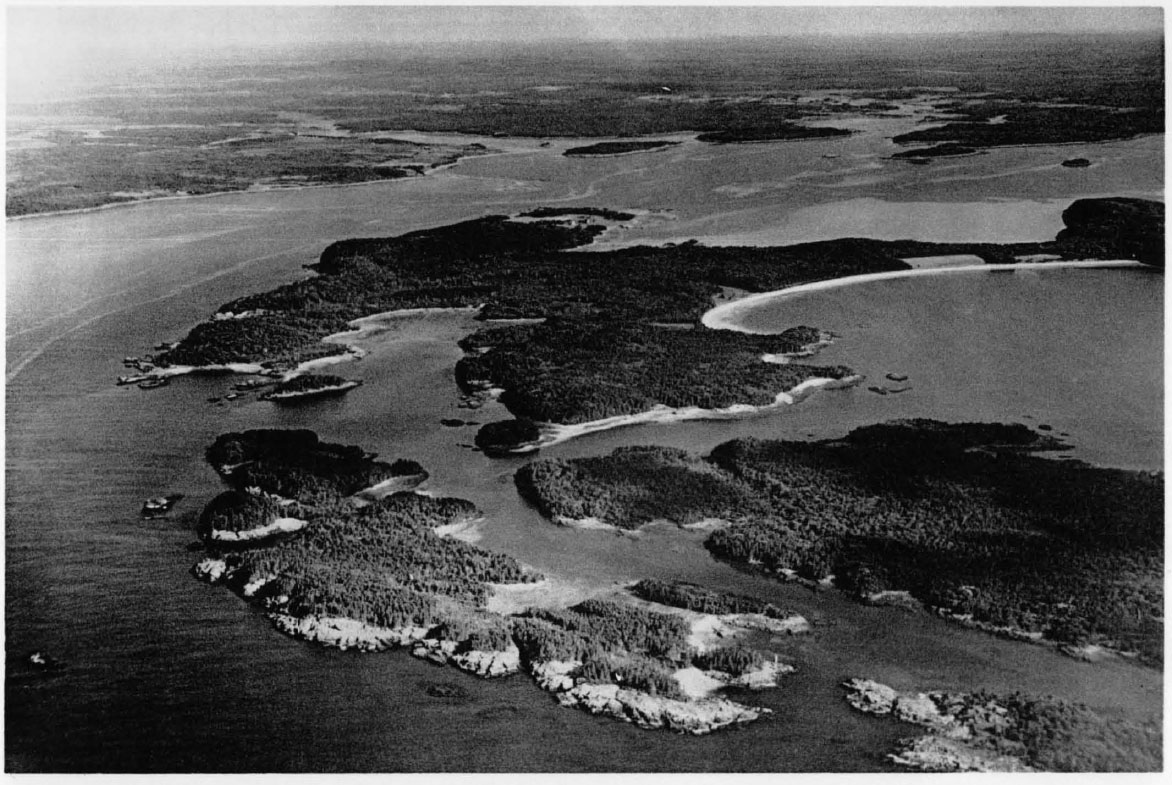
1. Roque Island.
Aerial view by Dr. Alexander Forbes, 1935.
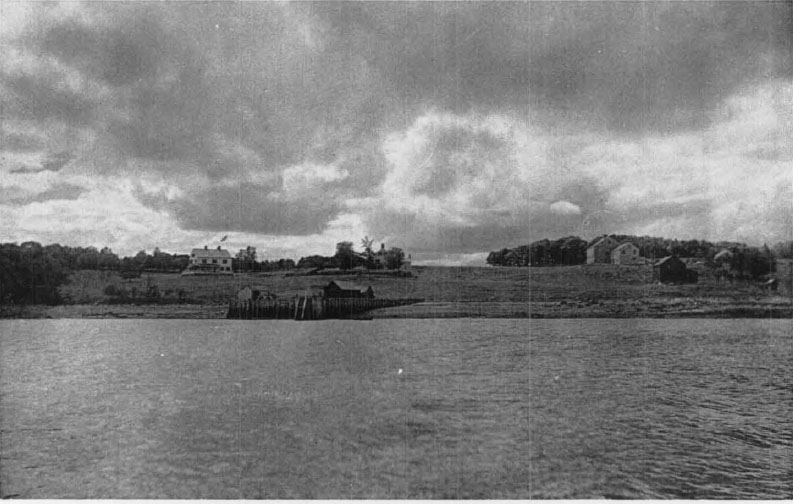
2a. The buildings on Roque Island, from the water, 11 September 1909.
Photograph by John Lowell Gardner, 2nd.
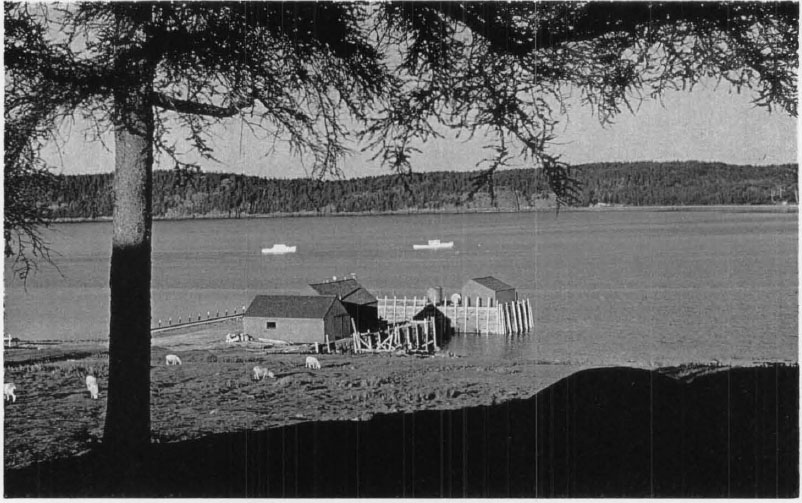
2b. The wharf on Roque Island.
Photograph by John Peabody Monks.
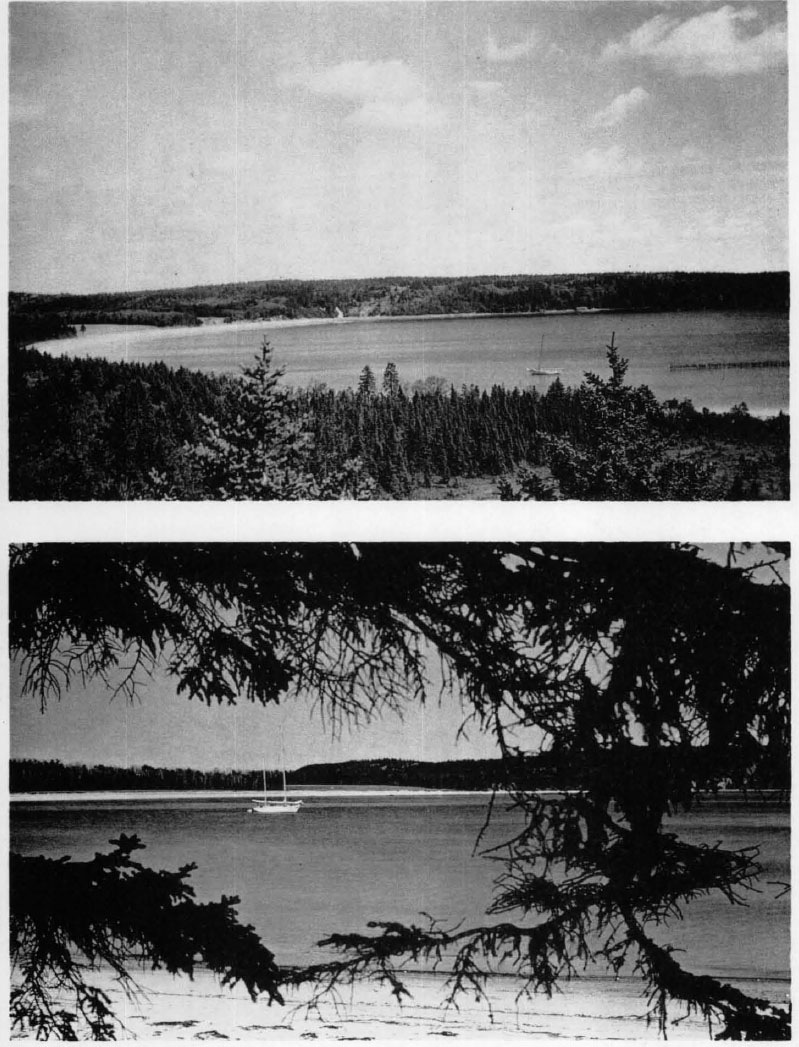
3. Great Beach, Roque Island.
Photographs by John Peabody Monks.
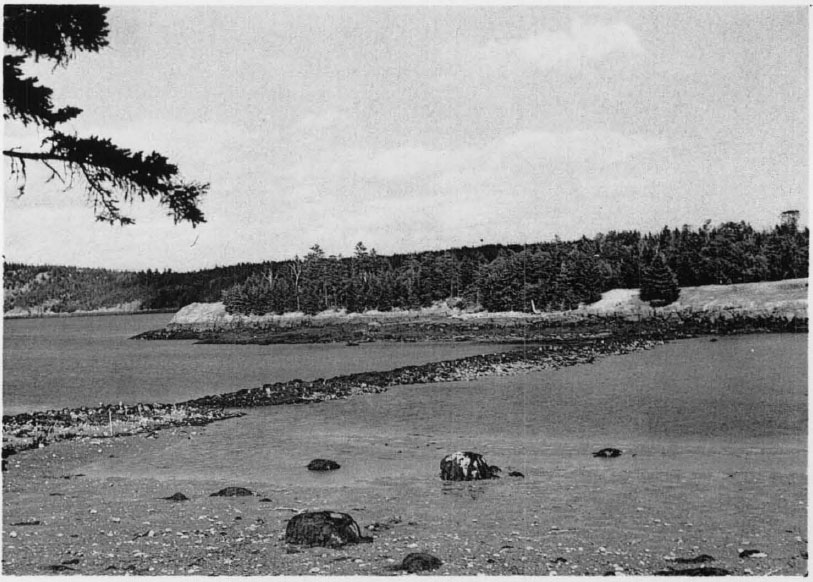
4a. Paradise Cove, Roque Island, at low tide, showing mill dam, 1954.
Photograph by John Peabody Monks.
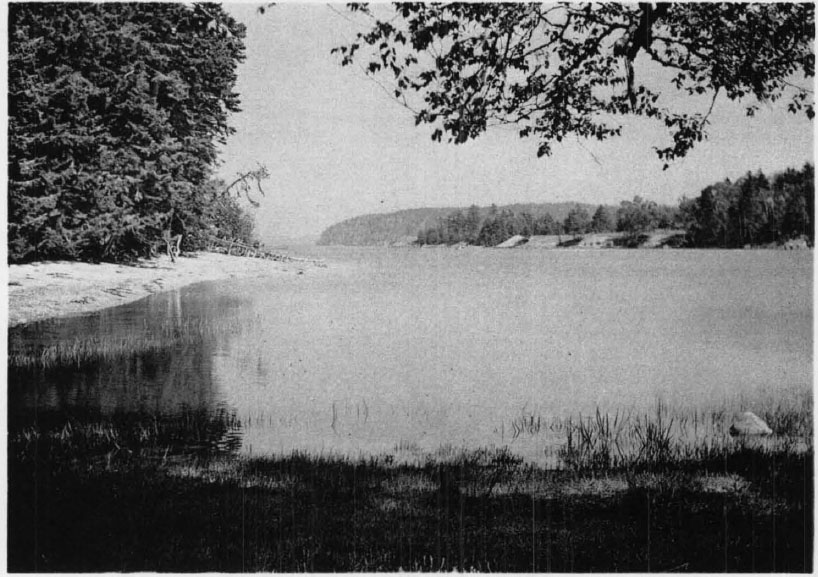
4b. Paradise Cove, Roque Island, at high tide.
Photograph by Gilbert Congdon.
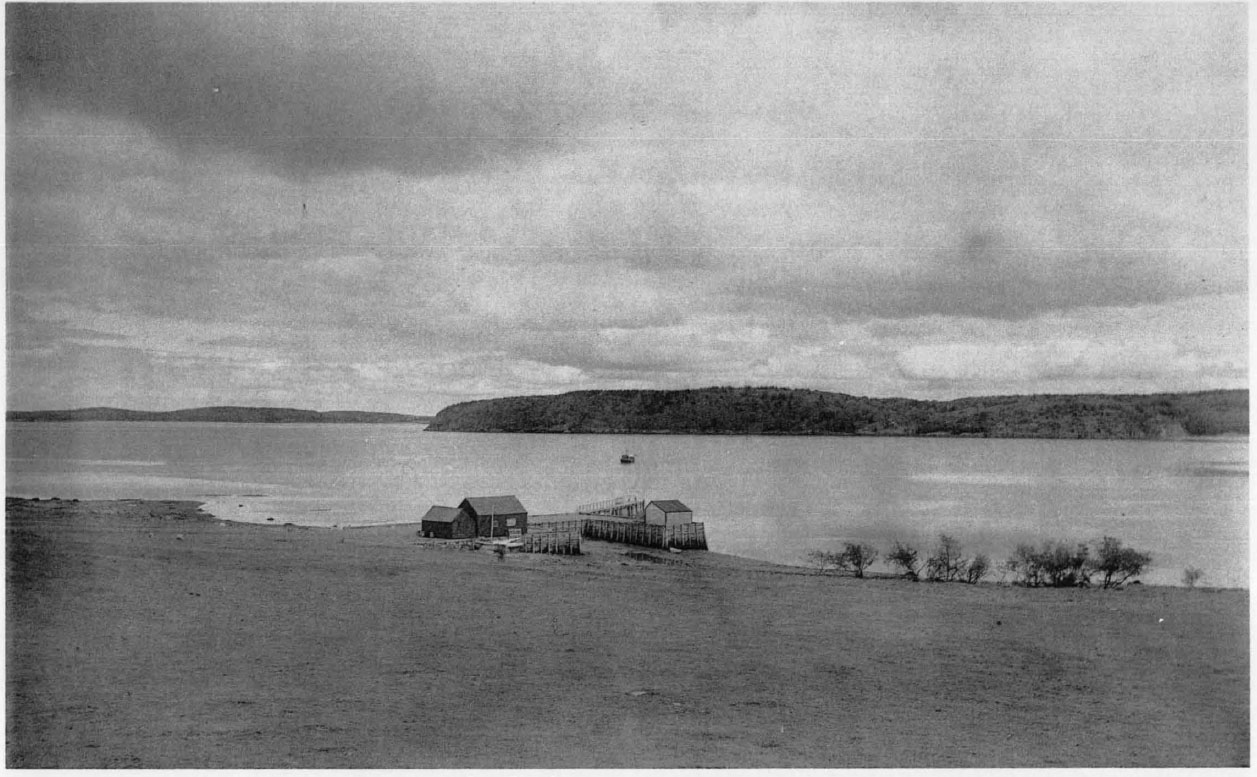
5. The Head from the New House, Roque Island, 11 September 1909.
Photograph by John Lowell Gardner, 2nd.
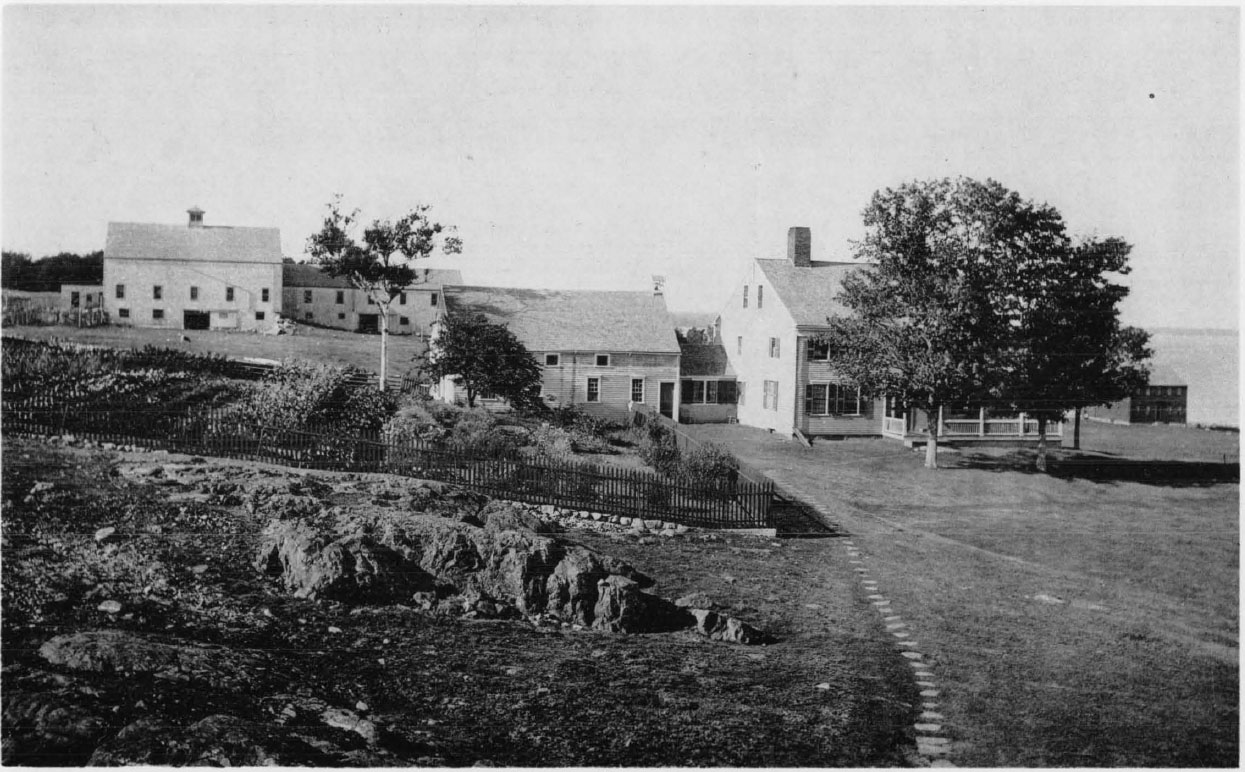
6. Old houses and barn from the New House, Roque Island, 6 September 1909.
Photograph by John Lowell Gardner, 2nd.
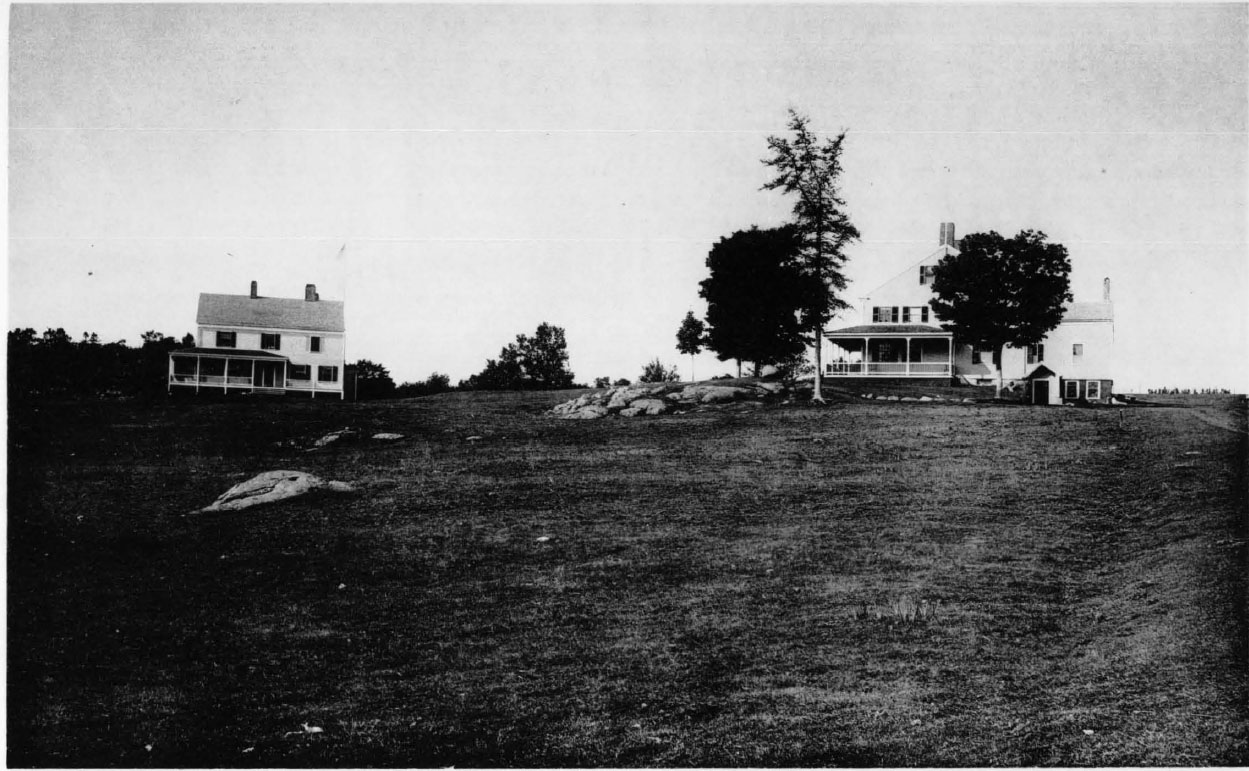
7. New and Old House from the wharfy Roque Island, 1907.
Photograph by John Lowell Gardner, 2nd.
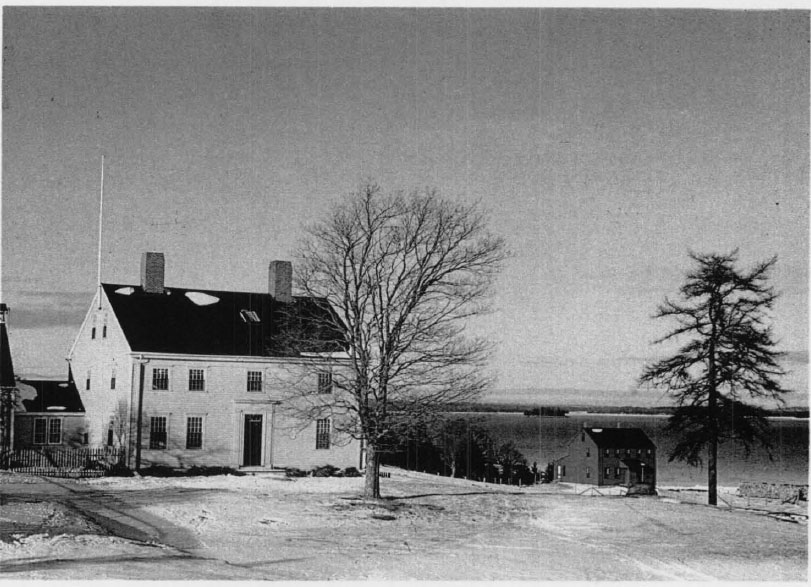
8a. The Old Farm House in winter, February 1941.
Photograph by John Peabody Monks.
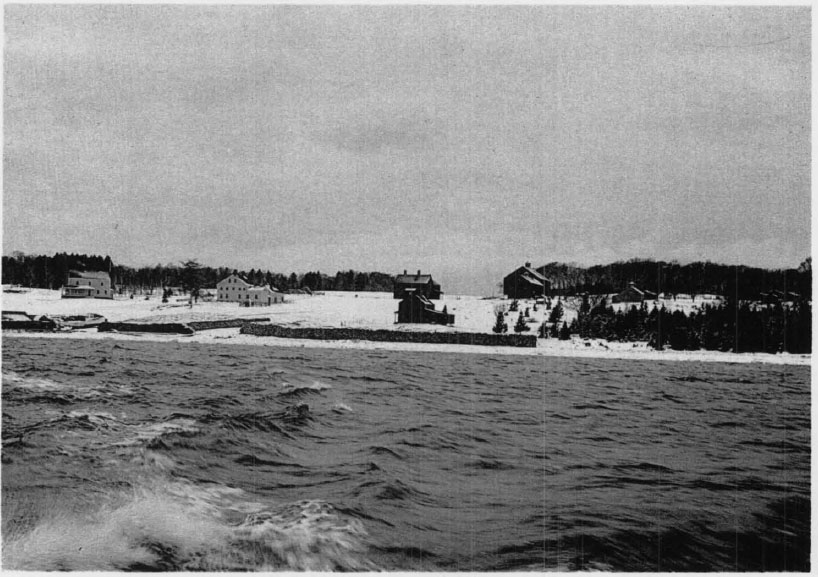
8b. Leaving Roque Island, February 1941.
Photograph by John Peabody Monks.
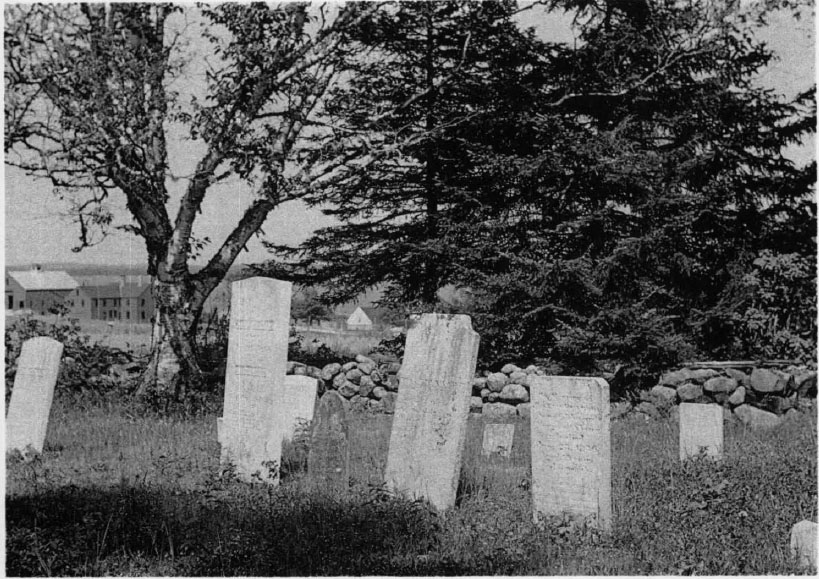
9a. The graveyard, Roque Island.
Photograph by John Peabody Monks.
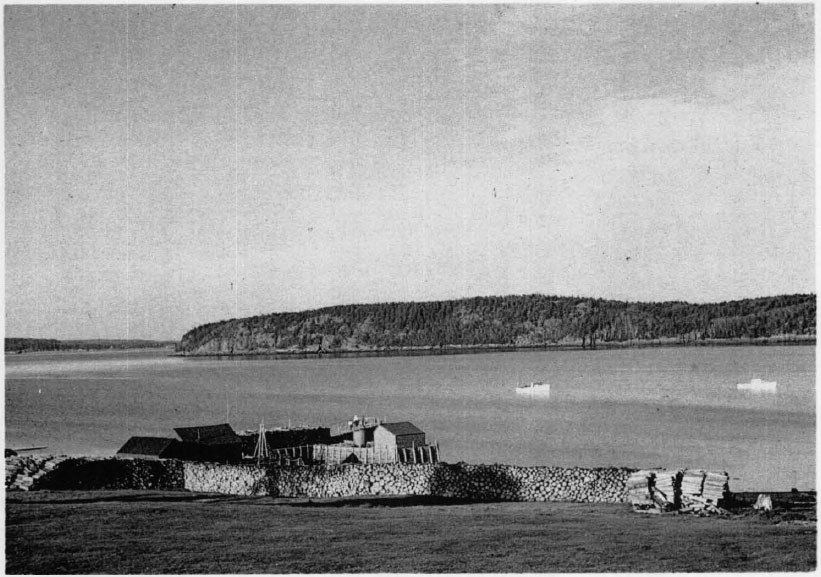
9b. The Head from the New House, with timber at the wharf.
Photograph by John Peabody Monks.
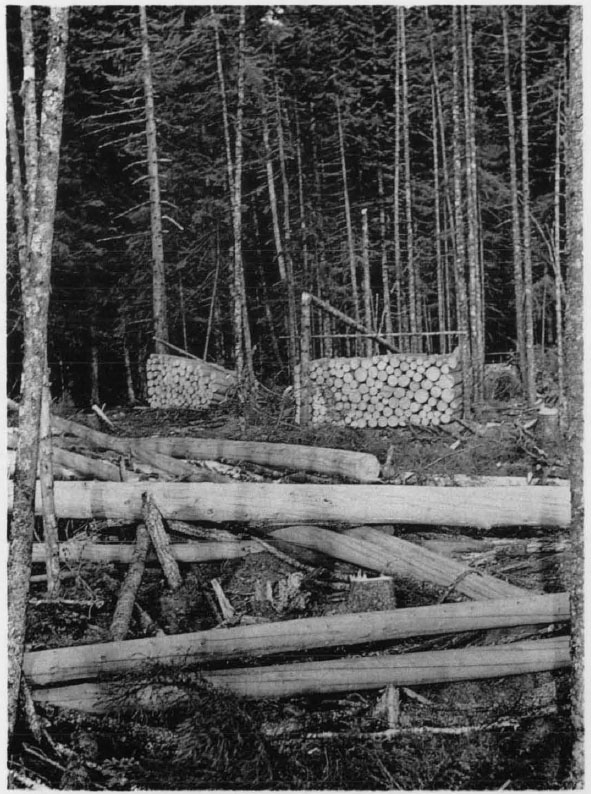
10a. Timber awaiting transportation.
Photograph by John Peabody Monks.
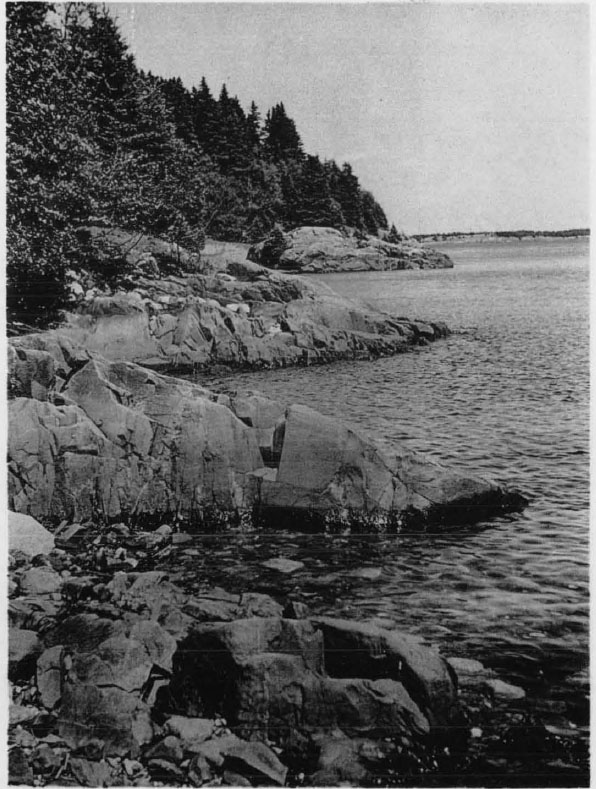
10b. Indian Landing from Thoroughfare Point.
Photograph by John Peabody Monks.
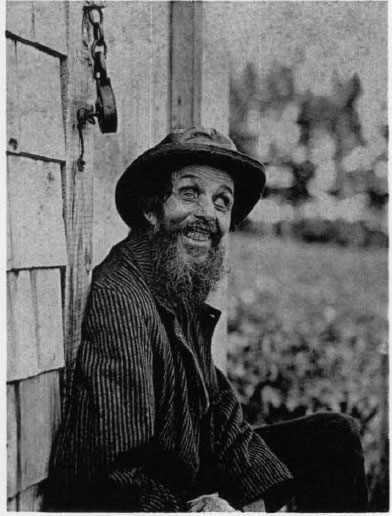
11a. Daniel Ingalls.
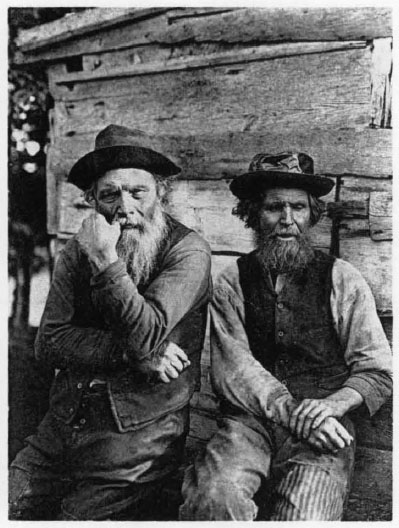
11b. William and Nehemiah Ingalls.
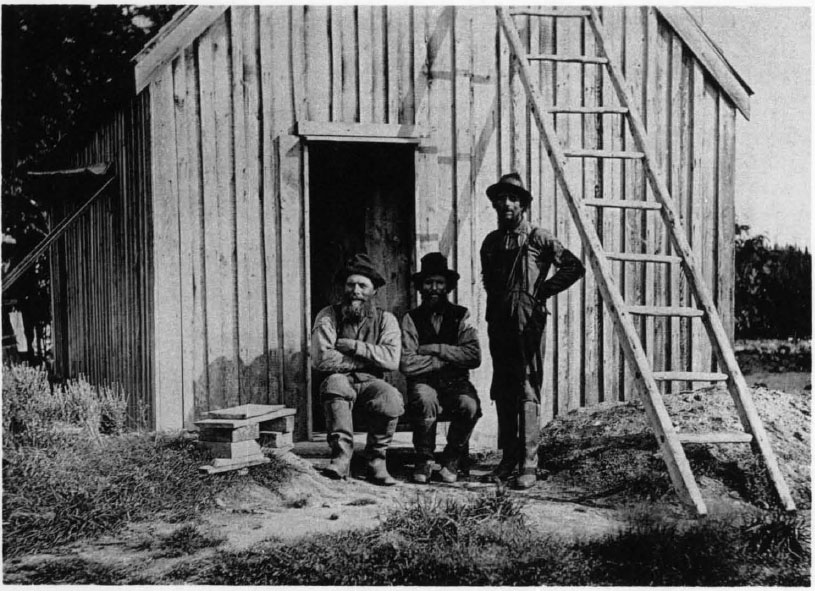
11c. The Hermits on Little Spruce Island in 1880’s.
Photographs by John Lowell Gardner, 2nd.
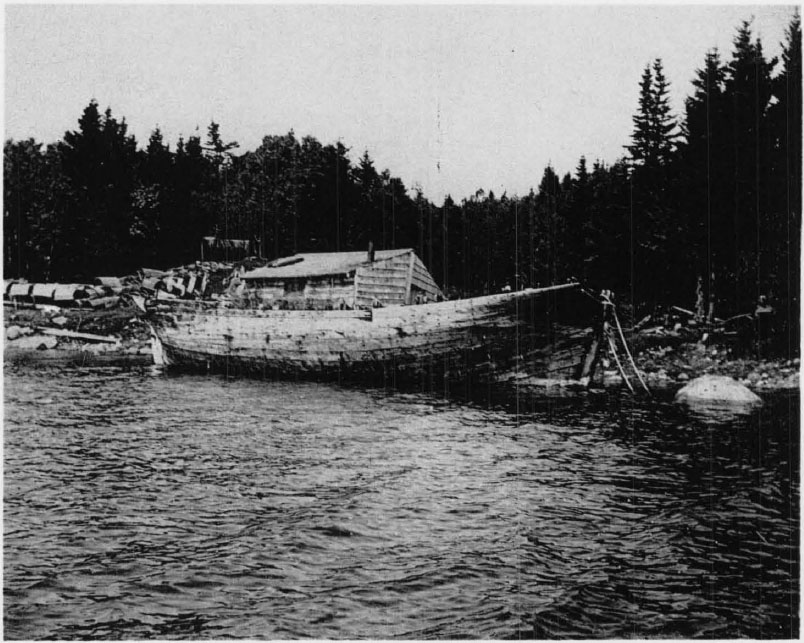
12a. Daniel Ingalls's gundalow, Great Spruce Island.
Photograph by John Lowell Gardner, 2nd.
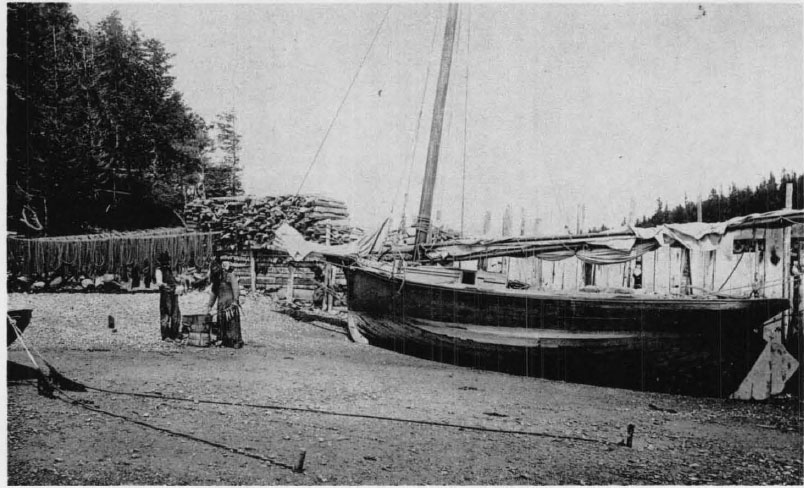
12b. Nehemiah and William Ingalls sticking herring, Little Spruce, 1888.
Photograph by John Lowell Gardner, 2nd.
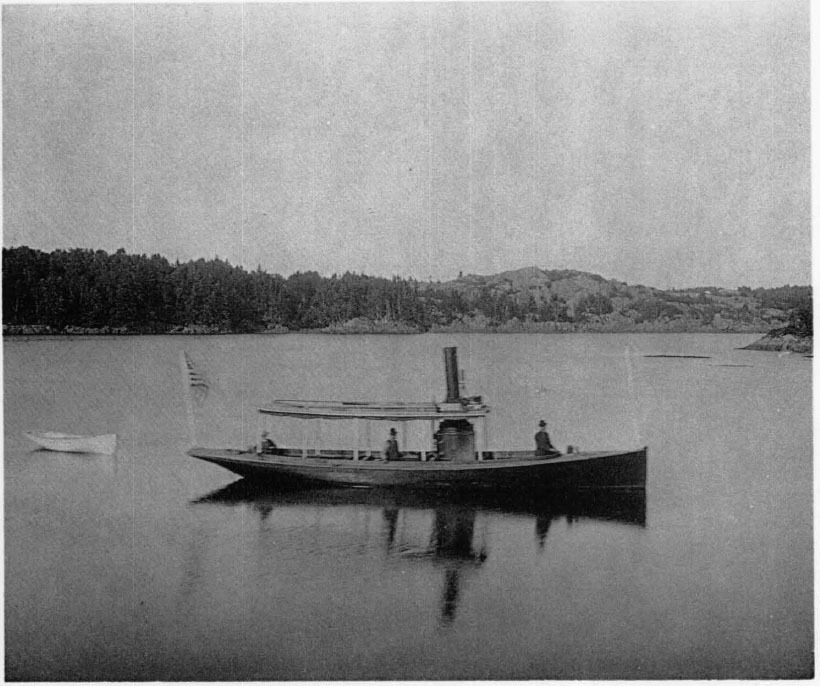
13a. Spruce in Thoroughfare between Great Spruce and Little Spruce Islands, 1889.
Photograph by John Lowell Gardner, 2nd.
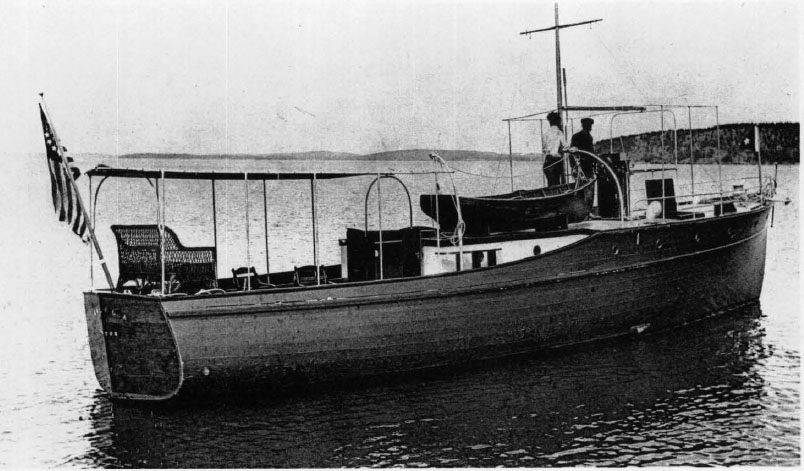
13b. Lalla.
Photograph by John Lowell Gardner, 2nd.
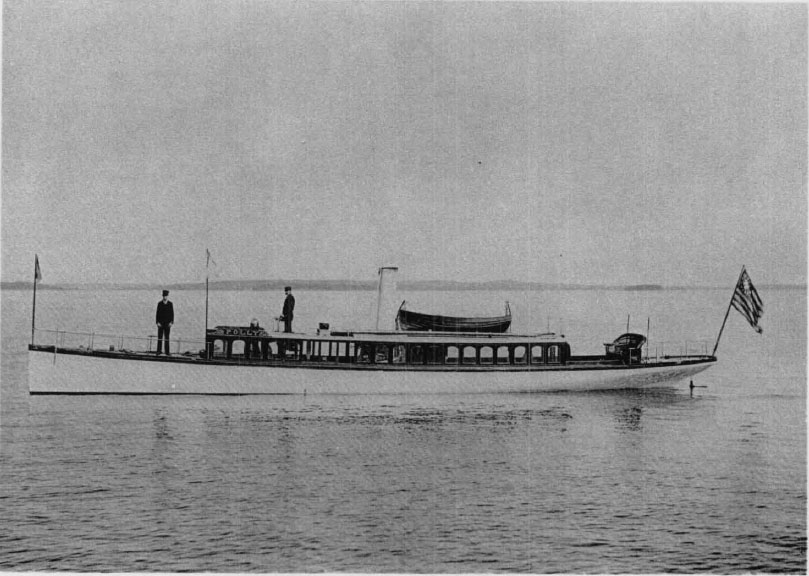
14a. Polly at Roque Island.
Photograph by John Lowell Gardner, 2nd.
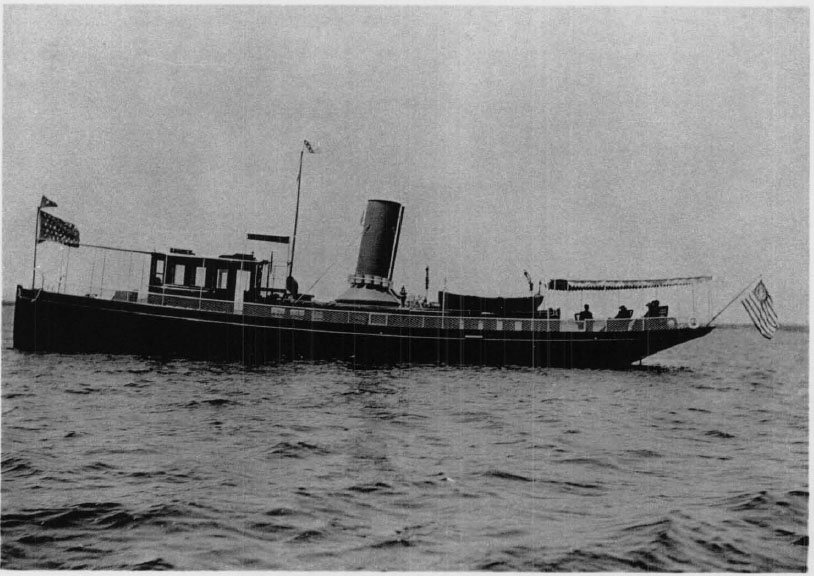
14b. Roque at Monument Beach, 4 July 1904.
Photograph by John Lowell Gardner, 2nd.
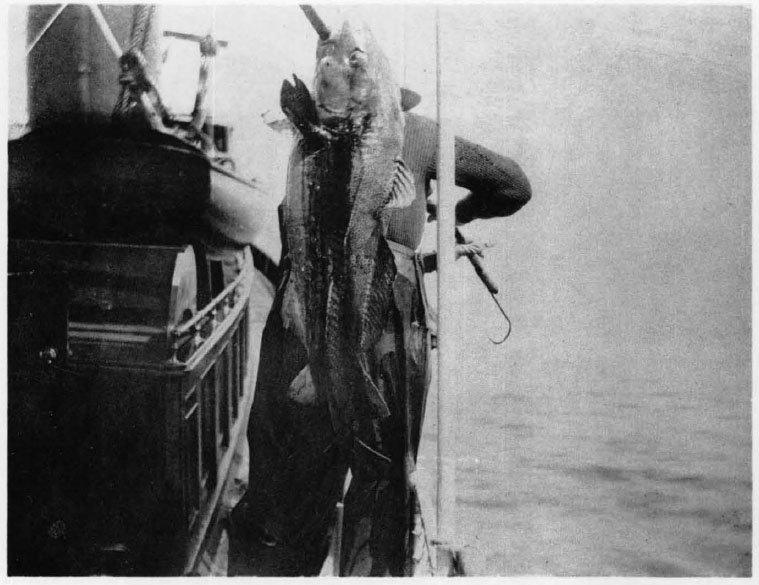
15a. George A. Gardner’s 39-pound cod, steamer Roque, August 1906.
Photograph by Mrs. George H. Monks.
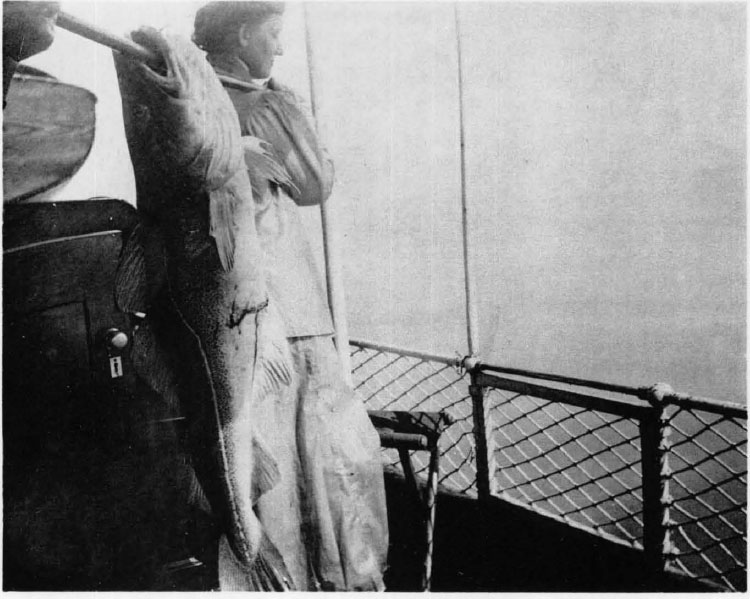
15b. Mrs. George H. Monks’s 52½-pound cod, the island record, steamer Roque, August 1906.
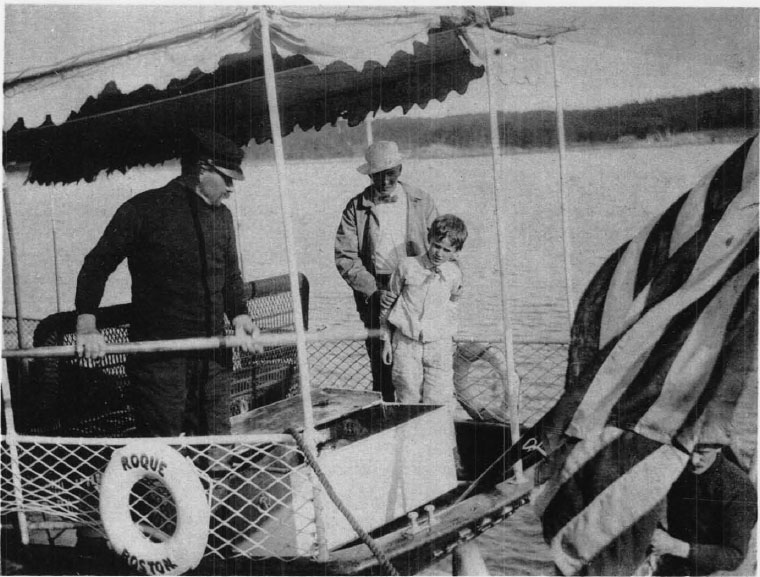
16a. Unloading fish from steamer Roque. Captain Watts, Dr. George H. Monks, George Gardner Monks.
Photograph by Mrs. George H. Monks.
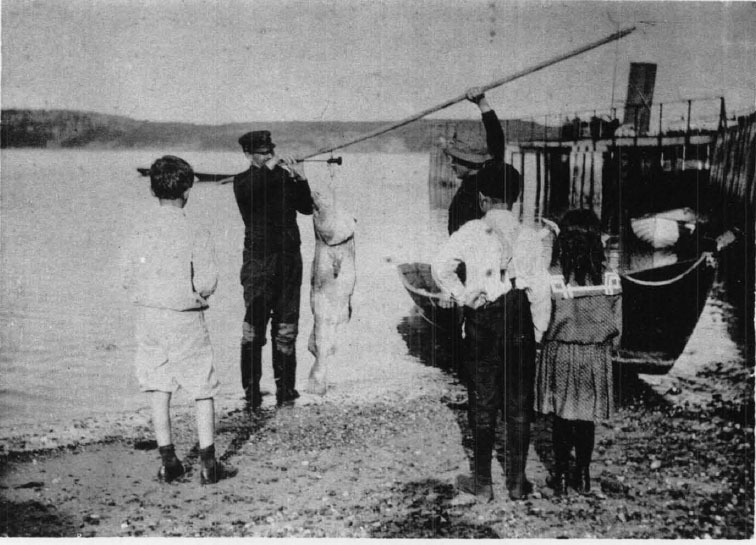
16b. Weighing Mrs. George H. Monks’s record cod.
Photograph by Mrs. George H. Monks.
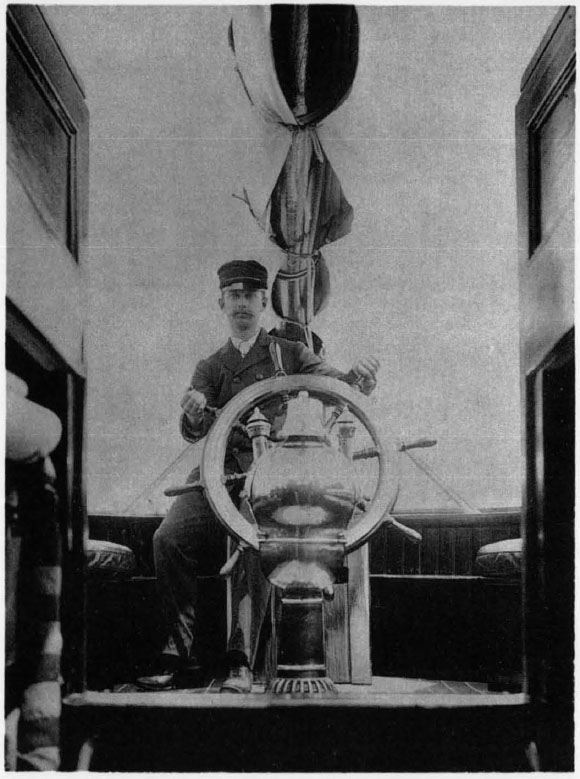
17a. William Amory Gardner, on his yacht Rebecca, at Roque Island, 31 July 1888.
Photograph by John Lowell Gardner, 2nd.
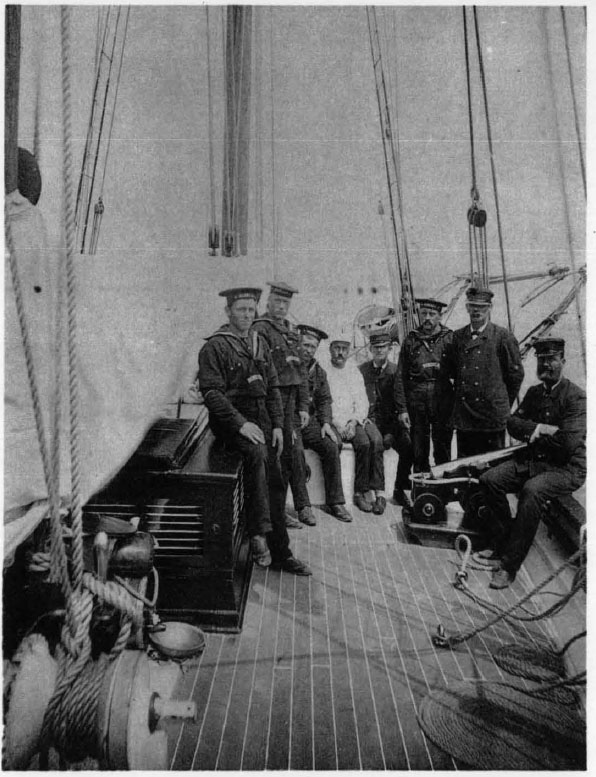
17b. William Amory Gardner's yacht Rebecca at Roque Island, 31 July 1888.
Photograph by John Lowell Gardner, 2nd.
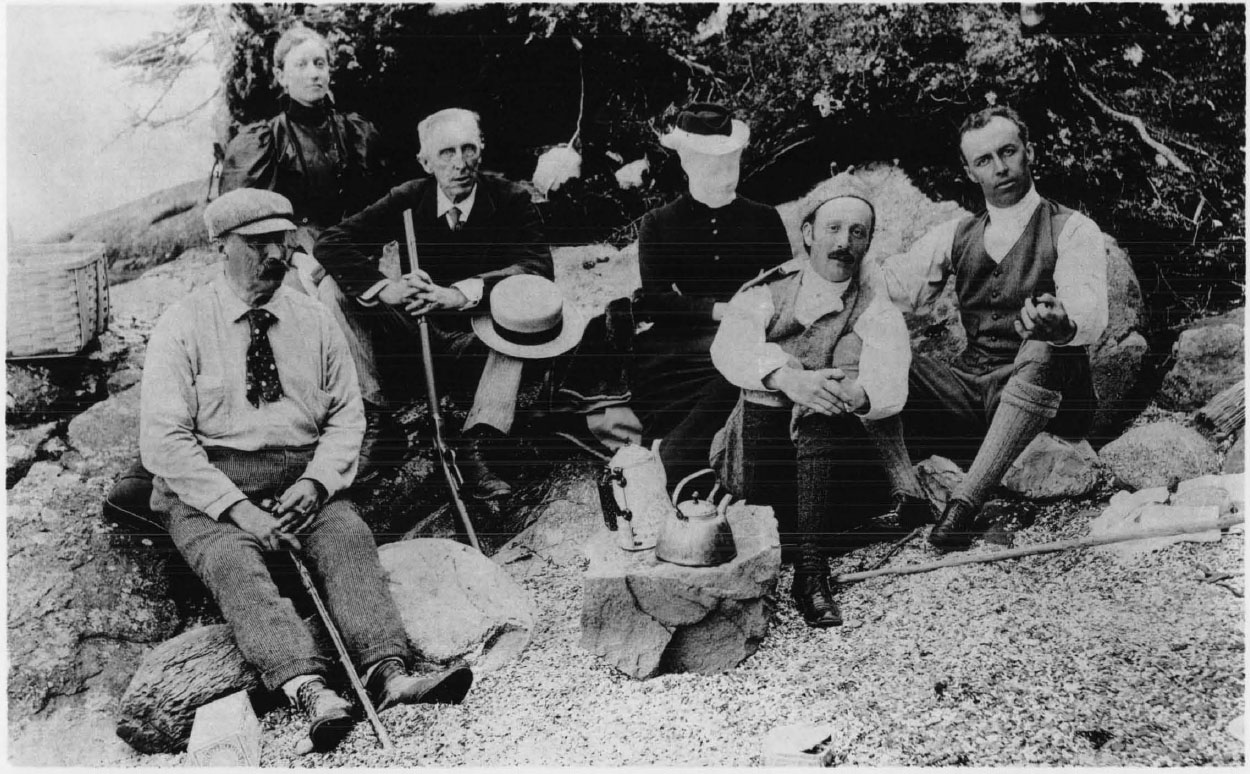
18. A picnic at Roque Island, 1896. John L. Gardner, Olga E. Gardner, George A. Gardner, Isabella S. Gardner, Henry Ingersoll, George Eustis.
Photograph by John Lowell Gardner, 2nd.
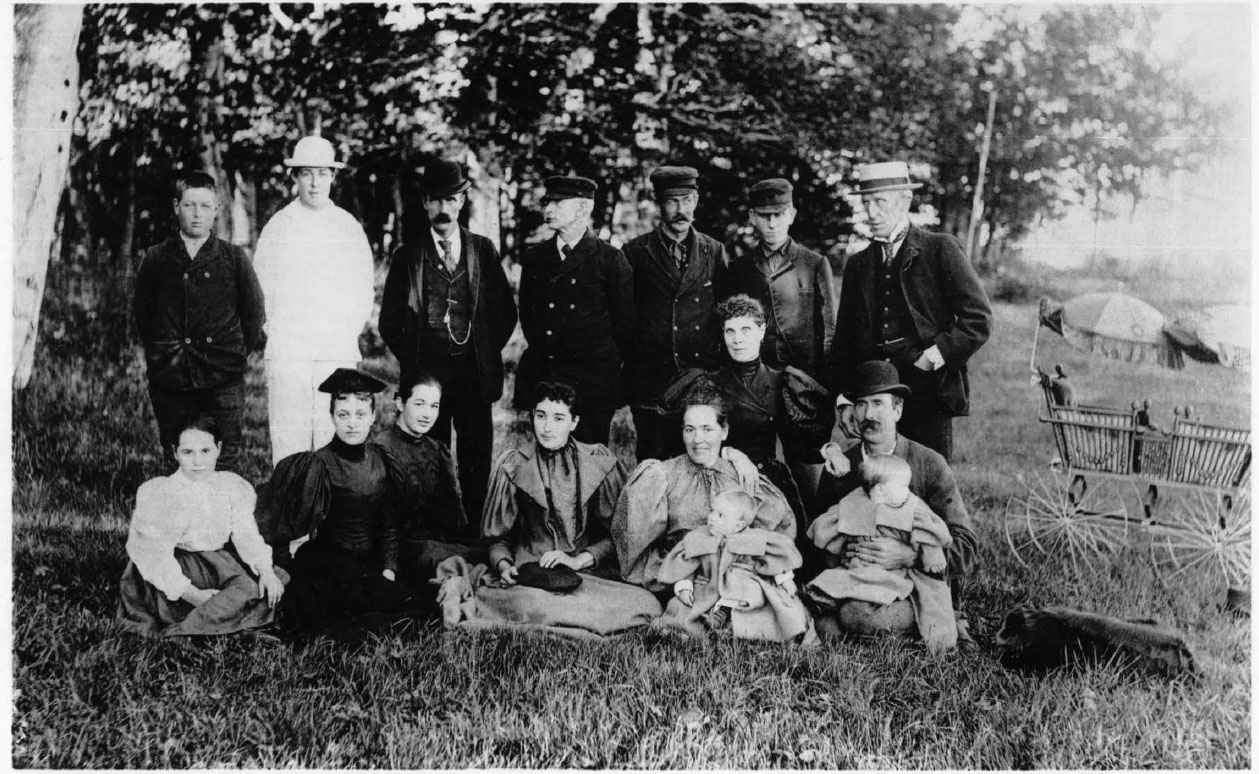
19. George A. Gardner with Roque Island employees, 1896.
(Back row) Merton Long, Stephen Watts, William Day, Thomas Craygan, Captain John Watts, Daniel Pendelton, George A. Gardner. (Front row) Mary Long, Mrs. Josie Day, Bertha Long, Jennie Thompson, Mrs. Ella Long, Lydia Brown, Helen Long and Herbert A. Long, Jr. (the twins), Herbert A. Long, Sr. Photograph by John Lowell Gardner, 2nd.
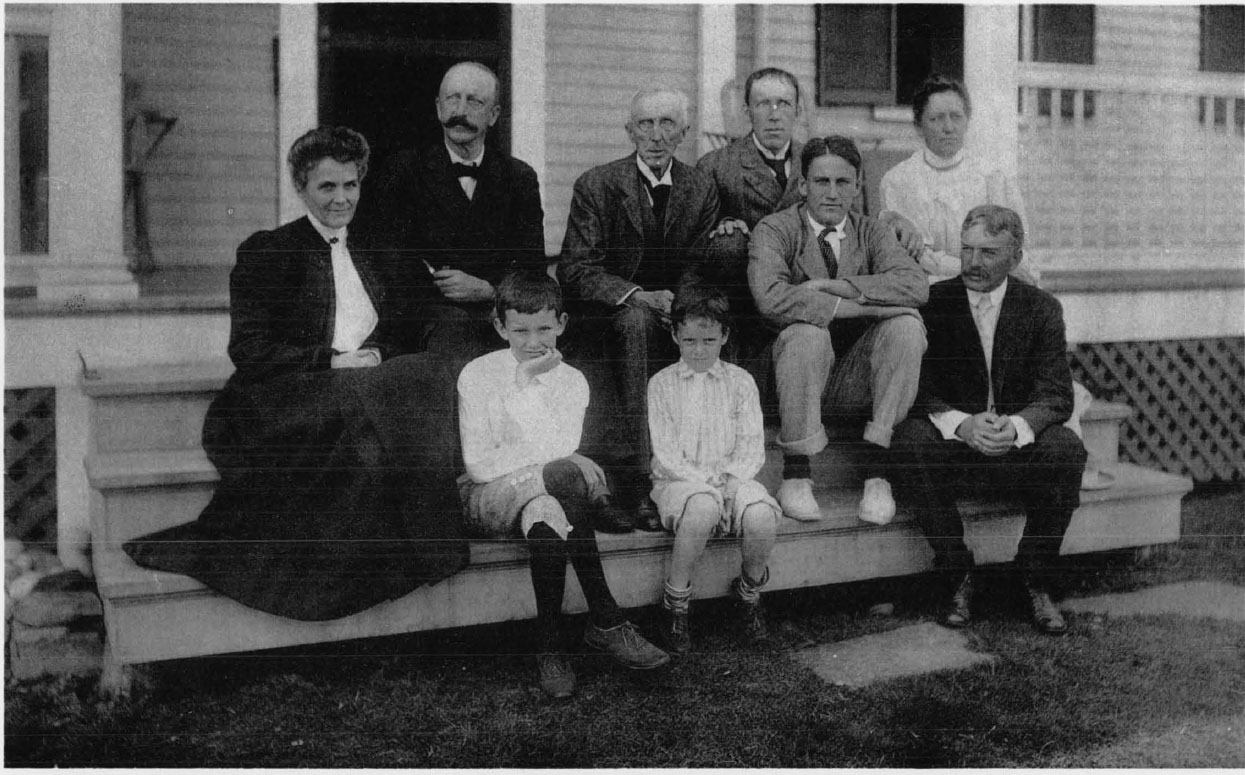
20. Group on steps of New House, Roque Island, September 1907.
(Back row) George P. Gardner, George A. Gardner, John L. Gardner, 2nd, Olga E. Monks. (Middle row) Esther Gardner, George P. Gardner, Jr. (Front row) G. Gardner Monks, John P. Monks, George H. Monks.
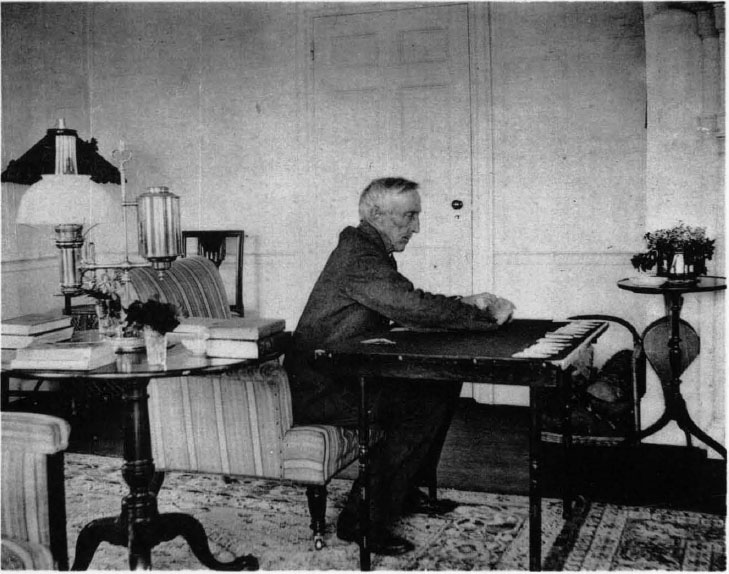
21a. George A. Gardner playing solitaire in parlor of New House, 1906.
Photograph by Mrs. George H. Monks.
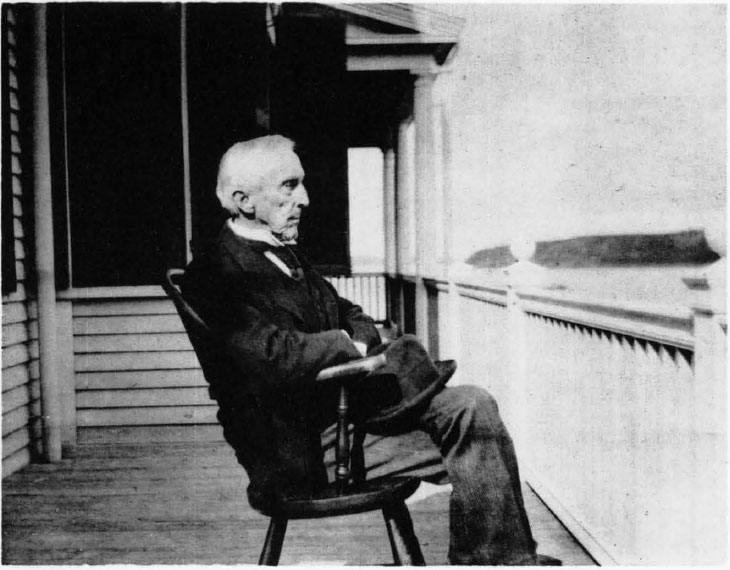
21b. George A. Gardner on porch of New House, 1907.
Photograph by Mrs. George H. Monks.
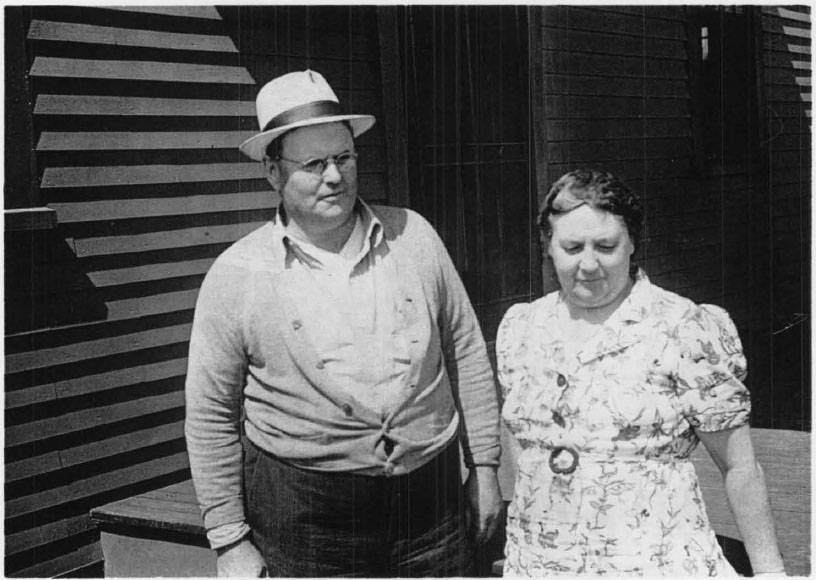
22a. Mr. and Mrs. Sewell Smith, 1940.
Photograph by John Peabody Monks.
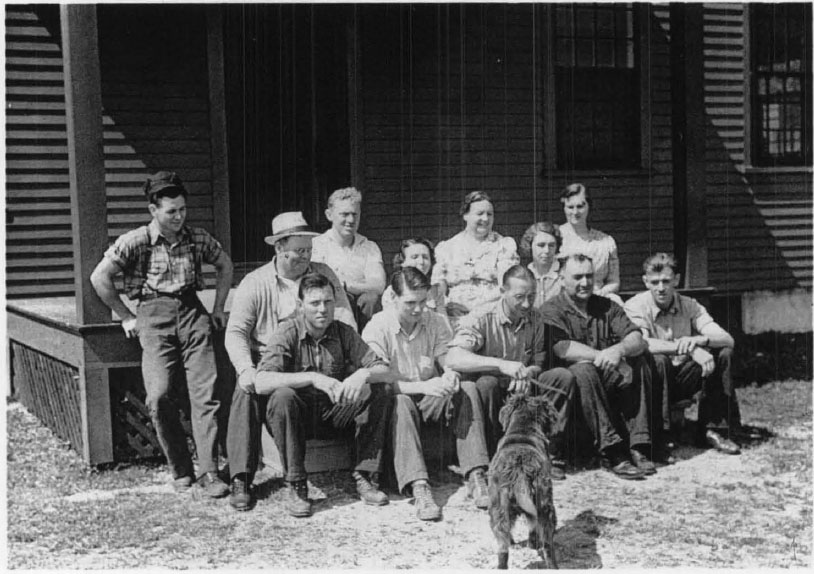
22b. Roque Island employees at Farm House, 1940.
Photograph by John Peabody Monks.
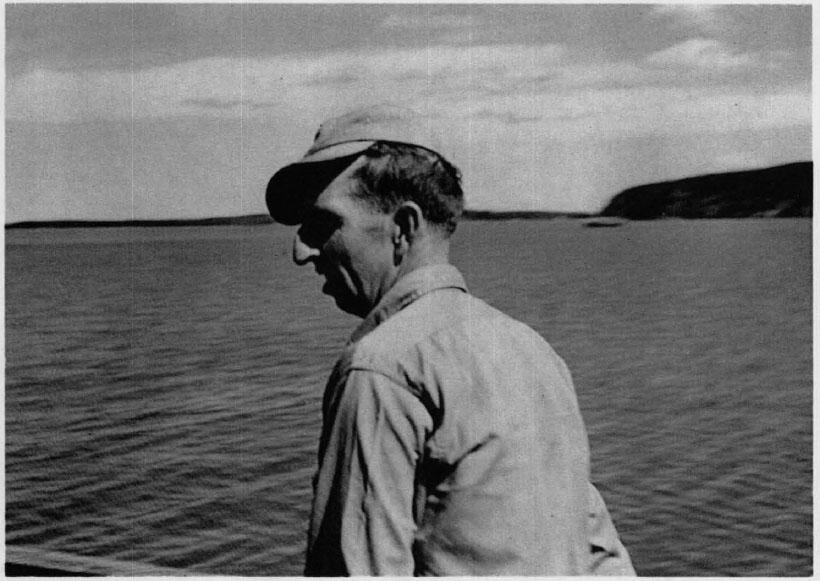
23a. Duke in 1954.
Photograph by John Peabody Monks.
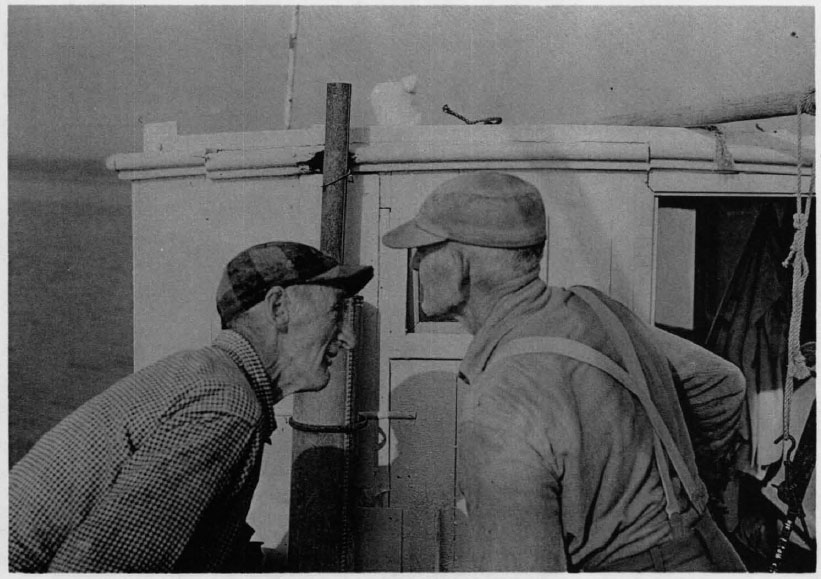
23b. Roque Island conversation, 1954.
Photograph by John Peabody Monks.
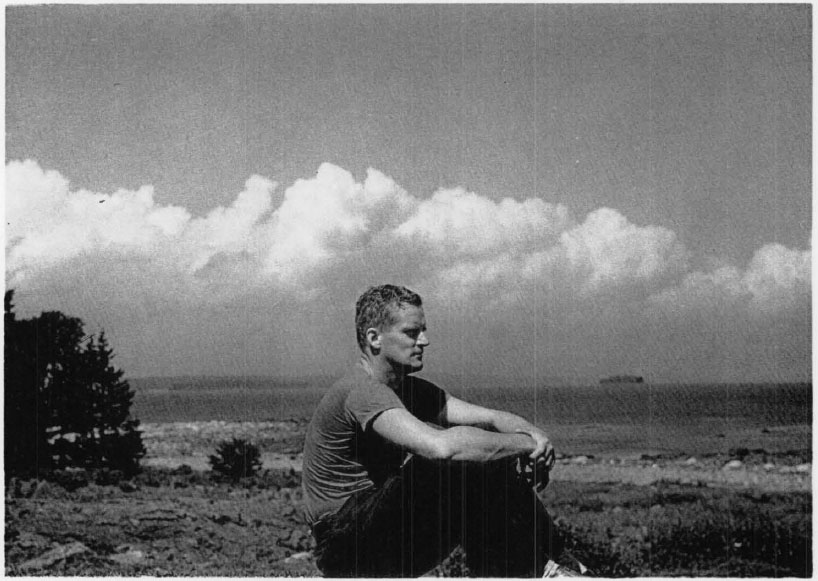
24a. Dr. John P. Monks, near Red House, Roque Island, 1946.
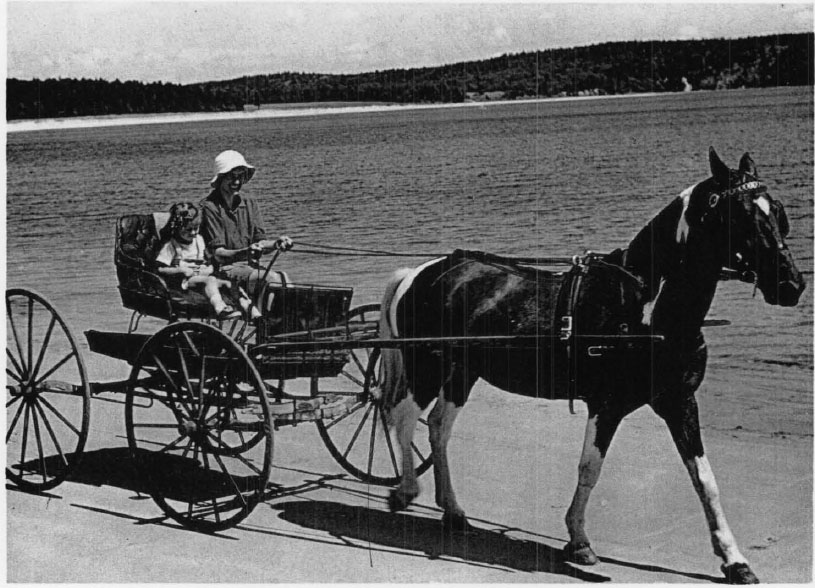
24b. Mrs. John P. Monks on Great Beach, Roque Island, 1939.
Photograph by John Peabody Monks.
George A. Gardner, though he only lived to 87, was no laggard in the trencherman tradition. Meals at Roque Island were traditionally heavy. At breakfast he might put down half a grapefruit or a Bartlett pear, hot cereal with cream so thick it could scarcely pour, eggs or fish, bacon, toast, blueberry muffins, butter, milk, coffee, chop and potatoes. When the writer and some young friends were at table with Grandpa one day, one guest dropped down on all fours and left the dining room crawling and groaning with the immensity of the meal he had just eaten, claiming that any other position was impossible for him to assume.
IV
At his brother’s death in 1898 George A. Gardner became sole owner of Roque Island, but he had no cause to feel lonely. His son John continued happy summers on the Island, studying rock formations and taking superb photographs. His son George Peabody Gardner, who married Esther Burnett; his daughter Ellen, wife of Augustus Peabody Loring, and his daughter Olga, who married Dr. George Howard Monks, all raised their share of young Roque enthusiasts. (See Plate 20.) Deep-sea fishing, his real love, was shared in varying degree by George A. Gardner’s grandchildren. Some enjoyed themselves immensely; others found rolling and drifting for hours in a fishy-smelling cockpit, hauling up and down long lines and heavy leads, far from appealing. The thought of blistered hands, hot sun, and possible seasickness made a fishing trip into mild hell for some, though they seldom said so.
The most prized catch was halibut; there were occasional pollock, and the undesirable dogfish, skate and toadfish. Cod was the chief catch. Eaten fresh, or cleaned, salted and dried, it made the Roque wharf smell like a commercial fish pier. Competition brightened the fishing. A pool was collected, or someone great-heartedly donated one; then twenty-five cents was traditionally awarded for the first fish, the same amount for the most, and for the largest. On 17 August 1906, one party caught sixty-two cod in just under two hours, said to be the best fishing of that year and the twenty years preceding. 1906 became known as a Year of the Big Cod when Olga Monks caught a 52½-pound cod, the Island record. (See Plates 15 and 16.)
There might be fishing prizes, but George A. Gardner was still very careful with his petty cash. Neither Mr. Long, the caretaker, nor Captain Watts of Roque was advanced so much as a twenty-five cent piece toward their expenses; one who knew their employer well exclaimed, “Generous—gracious no.” (See Plate 19.) It was an unvarying ritual on his last night at Roque for George A. Gardner to closet himself in the parlor and go over the accounts. Every last chicken and bucket of herring was tracked down, and if an expense voucher had been lost it was too bad. Mr. Gardner paid only bills presented in black-and-white.
Berrypicking, an appropriate Maine activity, once provided Roque’s owner with unexpected confusion. He went over to the mainland to pay some calls on local families; knocking on one door, he found it opened by a stranger. He asked if Miss-So-and-So was in, and had the reply, as he thought, “No, she’s out a-berrying.” He then said that if he might, he would wait until she returned, whereat the strange woman exclaimed, “I tell you, she won’t come back, she’s out a-burying, she’s dead!”
George A. Gardner was always one for plain speaking, and when thwarted, his temper was short. Though on the best of terms with Mrs. Long, who cooked for him in the early years, he used to drive her distracted by warming himself at her kitchen stove when she was trying to get on with the dinner. Latterly he had an English cook named “Belle” with whom he would occasionally cross swords. Belle, sensing his desire to take her to task, would from time to time withdraw to the laundry in the cellar. There her employer would relentlessly follow her, strong language would ensue, and their arguments routinely ended with Belle’s declaration, “Well, Mr. Gardner, if that’s the way you want it, that’s the way you shall have it!” Regardless of how he felt, it is certain that Belle left these encounters firm in the assurance she had won.
When Gardners quarreled with one another they could be fearfully stubborn. George A. Gardner’s grandson, Gussie Loring, a college boy at the time, had been cruising with a friend and anchored in Shorey’s Cove. The wind came up, and Gussie was anxious to get to his boat, as the anchor was dragging. His grandfather objected, saying it was blowing too hard, but Gussie went out anyway, let out more scope and slept aboard. Next morning when he came ashore for breakfast and started to kiss his grandfather, Grandpa turned away and went upstairs. Gussie exploded with a “To hell with you!” and returned to his boat, where he cooked lunch. All that day his cruising companion rowed back and forth vainly attempting to make peace. Finally at five o’clock Gussie, who maintained all along that he had only saved his own boat, came ashore and apologized to his grandfather, saying he was a “wilful boy.” In return his grandfather kissed him, gave him twenty dollars, and, peace thereafter reigning, Gussie Loring and George A. Gardner dined together every Thursday night of the college year following.
Ducks were not always as cooperative as humans. When George A. Gardner was an old man he found himself celebrating a birthday at Roque all alone. Therefore, as it was his custom to offer food to the ducks from the front porch steps, he poured out some champagne in a bowl and offered it to them there. At first they rushed at it, but then backed away. He pursued them, pushing the bowl towards them, until finally, convinced they wouldn’t drink any, he threw bowl, champagne and all, at the ducks, and stumped away indoors.
Woodchopping was an occupation pursued by George A. Gardner long after his doctor had told him to stop. He used to go out with a towel; when he got overheated at his work he would rub down with it, put on his shabby old coat and return home, as he thought, with no one the wiser. For many years the forest on Roque had been left to itself, safe from lumbermen, and the Gardner brothers did their best to avoid any wholesale chopping, or commercial timbering. Still, there were many days to be spent in clearing existing roads and paths, or opening up new ones. The Island “crew” of workers did the heaviest work, but long after George A. Gardner’s day trail clearing was a favored occupation. It was expected that all healthy males, owners and guests alike, would do their share; women also helped in the trail blazing. There seemed to be an endless amount of axe work: the enthusiasts fell to with good will; the nonenthusiasts were prodded, or sometimes almost shanghaied, into taking axe or saw in hand. Sometimes the persuasion was too vigorous, but people generally gave in gracefully. For those weary of the city, beating back the wilderness, beating back encroaching forest, and dragging brush gave a prideful sense of accomplishment.
Even pigs did good work on Roque Island. Shortly after the turn of the century, and for many years thereafter they were allowed to roam at will. Consequently they found their way down to the shore at low tide, and learned to dig and devour clams. Then for a time no pigs were kept on Roque, and when a new lot was brought in the secret seemed to be lost. Then once again, some bright pig caught the idea and taught the others. In recent years the pigs have been confined to a pen; now only people dig for clams.
Cows, goats, sheep, hens, ducks and turkeys were among the other animals stocking the Roque farm. In July 1907 the barn, dating from Joseph Peabody’s day, was struck by lightning and burned to the ground. One horse, 35 turkeys, 12 geese, 50 hens, a hog, and all the farm tools were destroyed; and Frank Smith, then caretaker, traveled to Boston to report the situation. George A. Gardner asked G. Peabody Gardner if the barn had been insured. When told that it was, for $ 1700, his sole comment was “Haw! I wouldn’t have taken that for my turkeys!”
By the summer of 1908 there was a fine new barn, and a larger fish house was also built. A boathouse, coal shed, and pump house had been built as they were needed, and with so much construction it was inevitable that some unwelcome changes might be proposed. Frank Smith suggested one time that the Red House be painted yellow like the Old House and the New House, to which his employer rejoined, “Mr. Smith, I don’t care what color you paint the Red House as long as it’s red. It always has been.”
This concern for keeping things as they always had been was sometimes irksome to those who had to carry it out. When a paper hanger was called in to work on the New House one summer he told Frank Smith he was going to paste back some loose wallpaper. Smith urged him to “Go over and patch up the hall wall-paper, but don’t do it too well, because I’ve been pasting it back for I don’t know how many years, and I’m hoping if it isn’t too good a job they’ll get some new paper!”
Frank Smith’s son Sewell, who later took over as Island caretaker, was used to George A. Gardner’s eccentricities from an early age. There was an ugly bull which Frank Smith had ordered tied up, so no one wandering around the pasture would be hurt. Mr. Gardner, then over 70, arrived and asked why the bull had been tied; then said he was to be turned loose and he and his party would stay clear of him. Shortly afterwards Sewell, at the barn, saw the bull start after Mr. Gardner, who was halfway across the Home Field on his way to the graveyard. As Mr. Gardner made for the fence, the bull right behind him, Sewell took a swing at the bull with a cart stave and knocked one horn off. This stopped the bull. Sewell then told Mr. Gardner to climb the fence, but he didn’t, as he wanted to know what Sewell was going to do next. Sewell proceeded to knock the other horn off the bull, whereat Mr. Gardner climbed the fence; Sewell was close behind, but got his wind knocked out. When George A. Gardner had helped him to his feet, he asked what Sewell’s father would say. Sewell said he would say “It was a question of me or the bull,” and Mr. Gardner finished, “Well, unless you have to, don’t tell him that I was mixed up in it!” Frank Smith never did find out that his employer was mixed up in the great “bull-fight.”
One day when George A. Gardner was chopping in the woods with his son John and some others he cut himself just below the knee. John tied up the wound and went back for a horse and cart. Meanwhile his father decided to walk out, though he had agreed to stay put. After considerable argument he was persuaded into the cart. On reaching his house he objected when the others tried to carry him up to bed; he lay in the cart kicking at all who approached. Finally one of his maids, Mary Matthewson, threw herself over his legs and refused to get off. Thus defeated, George A. Gardner allowed himself to be carried upstairs. The wound, a relatively slight one, was sewed up promptly by a Jonesport physician who happened to be on Great Beach at a picnic.
Sewell, being young and hearty, was often sent out with Mr. Gardner as the only one who could keep up with him. At the age of 76 this hardy soul suddenly jumped off the porch of the New House and sprinted all the way to where Roque was tied up, vaulting over her railing as a final gesture. Sometimes his athletic exploits could not be copied successfully. George H. Monks’ brother-in-law, Walther Hempel, visited the Island in 1910. He was a German professor of chemistry, and though beloved by all he met for his attractive personality, was a formidable-looking figure in his full spade beard and frock coat. Dressed for a picinic on Anguilla as he would have been for the classroom, the Professor was picking his way along some slippery seaweed-covered rocks. George A. Gardner had reached the water’s edge, where Sewell Smith was waiting with a rowboat, with the help of a long staff he carried on Island walks. Seeing that the Professor was in difficulties, he stamped his foot and said “Put your foot down firmly the way I do.” In the process, he nearly fell down himself, but was rescued by Sewell. The Professor had no such luck. Putting his feet down “firmly,” he found both of them flying in the air and he came sliding down over the rocks, tight frock coat ripped in back all the way to the neck. When both his passengers were safely aboard Sewell rowed them to Roque; they went into the main saloon while the boat was hoisted aboard and cradled. When this was done, Mr. Gardner popped his head out and asked solemnly, “Haw! Why don’t you laugh?” Sewell, who had nearly smothered in the effort not to, now dove for the forecastle ladder, and let go his pent-up laughter.
Though George A. Gardner came every year but three of the thirty-five he owned Roque Island, his recollections of his adventures there were practical, rather than sentimental. For his children and grandchildren there was something magical about vacations on the Island. Leave-takings there were even more reluctant than elsewhere. (See Plates 2a and 8b.) In the writer’s childhood they took place after supper, just as dark was falling. The bags came down to the wharf by cart, one made one’s farewells, and climbed into the launch. Then as she backed away and circled round to the course for Roque Bluffs, three miles away, the flag on the farmhouse came down in salute. Then a large bonfire, carefully constructed by Uncle John on Squire’s Point, was touched off and by this blazing beacon the boats at their moorings were left behind, the launch went only a few yards away from the Head, and skirting the old weir at Roque Bluffs, made fast to the wharf there. Henry Watts would be there waiting with his two-horse buckboard, and on a chilly night, with the stars out and the bonfire only a twinkling spot of yellow light, everyone was glad of the buffalo robes he tucked all round. It was a seven-mile ride to Machias; knowing one was saying good-bye to Roque for another year made all the smells and sounds more wonderful: one passed a sawmill, sniffing freshly cut timber; Henry released the brakes and the buckboard swept downhill onto the covered bridge, the horses’ cloppettyclop echoing loudly on its roof and sides. Then the drive was done, and the night train boarded; freshly peeled spruce staves and bags of fir needles must serve to recall, for almost a year, the Island vacation.
In 1913 the steamer Roque was sold, for a mere $800; considering that she was still at work, for a sardine company, more than a quarter-century later, it seems a modest sum. She was replaced by Lalla, 49 feet long (see Plate 13b); other boats of the period at the Island were Get There (which in 1912 had needed a new engine to live up to her name) Uncle Gus, Anguilla, Little Spruce and Little Roque. George A. Gardner was as fond as ever of his Island; in the last years of his life, though shaky from a heart condition, he even managed to elude the doctor who came down to Roque with him, and take Sewell out with him on woodchopping excursions. There, by means of the towel rubdown already described, and resting between bouts with the axe, he felt a cheerful glow of accomplishment, the more so as his activities were strictly forbidden! On 6 August 1916 George A. Gardner died, leaving Roque Island in equal shares to his children John L. Gardner, 2nd, George Peabody Gardner, and Olga E. Monks.
Over the next twenty years, though Roque continued as agreeable a resort as ever, there were no spectacular changes made on the Island. George A. Gardner had established a trust fund to help pay the expenses at Roque; in addition there was a varying income from the sale of cattle, wool, and wood. Deficit expenses were divided among the three owners; John L. Gardner, 2nd, paying the greater proportion as he spent a good part of each year living in the Red House, while his brother and sister and their families could only come for visits. Sewell Smith took over as caretaker from his father in January, 1923; though he had spent most of the preceding ten years in the Navy and merchant shipping, his boyhood and growing up on Roque made him as knowledgeable about the Island as anyone. (See Plate 22a.)
Sewell’s knowledge of boats often served him well. He had often been out with his father in a fog when he would be called upon to navigate. Frank Smith was primarily a woodsman, not a seaman; he never used the compass, and in a fog he invariably went round in circles, getting more and more excited the more circles he made. Then Sewell would shut off the motor and listen for Libby’s foghorn, or any breakers, and would get them straightened out. Frank Smith was apt, after they had been in the boat for a short time, to turn to Sewell and say “I don’t know where I’m going, but you take me there!”
Captain John Watts, who was until the nineteen-twenties in charge of all the Island boats, and built several of them, grew, like many seafaring men, increasingly fearful of bad weather. He had never been particularly good in fog, and Sewell had several times had to bring him in on foggy nights. He always used to come to see George A. Gardner at breakfast time for the day’s instructions, and followed an inflexible ritual. He would trudge up the hill and in the backdoor; after a suitable interval the waitress would open the pantry door, and announce “Captain Watts, Mr. Gardner.” George A. Gardner would remark the weather was fine. Captain Watts then looked glum. “The fog will be blowing in, Mr. Gardner.”
Local knowledge was invaluable to Sewell on a foggy June day in 1933. Franklin D. Roosevelt in his younger days had often anchored in Lakeman’s Harbor on his way down East to Campobello. The harbor, which is practically landlocked by Roque, Marsh, Lakeman’s and Bar Islands, has three entrances, two of which are not usable at low tide. For a Presidential vacation, Roosevelt had chartered the yacht Amberjack II, which was accompanied by the destroyer Bernadou and the Coast Guard cutter Cayuga. On 25 June 1933, Amberjack, Cayuga and a press boat dropped anchor in Lakeman’s in a thick, cold fog. Bernadou, due to her size, had to stay outside.
Word soon spread to the houses on Shorey’s Cove that the President was anchored in Lakeman’s. This came about because the Island boatman, Earle Matthews, had come across to Roque Bluffs for the mail, where a group of pressmen and Secret Service men detailed as bodyguards demanded to be taken over to Lakeman’s at once. Matthews replied that as a private boatman he had first to get the mail, then ask permission to take them over. After quite an argument the head Secret Service man agreed, and another boatman was hired for the job.
When Matthews brought the word back several people wanted to see the President, so Sewell Smith went down in Spruce, entering Lakeman’s through the narrow entrance between Marsh and Bar Islands. By idling the motor, and making very little noise, they went within thirty feet of the press boat before being discovered by someone who happened to stick his head up the companionway. They saw the President, seated in the stern sheets of Amberjack, apparently all by himself. Sewell gave him the old Navy salute, which he returned. Several men on the nearby cutter Cayuga then rushed for the lifeboat lying at her gangway and started for Sewell. He swung over to lobsterman Eddie Kelley’s wharf, and Spruce being freshly painted so her name and hail showed, the lifeboat’s occupants recognized her ownership and did not bother them further. Having seen the President, Sewell and his companions returned happily to the Island. Cayuga presumably learned that patrolling only one entrance to Lakeman’s was not enough!
Lakeman’s Harbor has always been popular with lobstermen, because it is well protected, has good holding ground, ample fuel, ample fresh water, and nearness to both inshore and offshore lobster pot areas. In the past there was a good deal of disagreement between owners and lobstermen about the land on the harbor, most of it quite unnecessary. Eddie Kelley, the only year-round resident, who first camped at Lakeman’s in 1889, maintained that over the years about forty fishermen had been based there, though never more than a dozen at a time.
At first the fishermen’s camps were built on scows anchored in the harbor, then Herbert Long, the Gardner’s first caretaker, allowed them to shore up the scows ashore. The first one, placed on shore where there was all the room anyone could want, was a galley off a coaster’s deck. It was 5½ feet square and 5½ feet tall, to keep down the resistance to wind and sea; transplanted to Lakeman’s it was lived in by a six-foot fisherman!
There was only just room for the man, doubled up, and a stove. The next “campers” were George and William Carver and Daniel Sawyer, who built small wooden shacks. Later an old two-masted schooner sheltered George Carver and “Cal” Dunbar. Long apparently intimated from time to time that all squatters might be ordered away from Lakeman’s at a moment’s notice; this gave rise to general uneasiness, and was the reason for the early camps being built on grounded barges. If the order to evacuate came, the scows could always be towed to water and anchored. George A. Gardner only learned of Long’s threats in this direction in 1893. One of the fishermen, Mark Bryant, gave his rowboat a tow to Jonesborough, and told him about them on the way. As Mr. Gardner did not approve of Long’s attitude, and said so, the fishermen began to feel more security, and started building new camps. Then Long put his foot down and said there should be no more than the existing number of camps, then about twelve. When Roscoe Johnson took over as caretaker, after Long’s death in 1903, it was brought to Mr. Gardner’s attention that the scows with camps aboard were gradually moving inland. To prevent the fishermen from acquiring the legal status of squatters, a nominal rent should be charged. This was set at a dollar a year; its collection proved, as Sewell Smith later discovered, “an awful job.”
Visiting yachtsmen, and the liquid supplies brought with them, have afforded lobstermen some notable parties in the past. On one such occasion Uncle Jud Carver played the violin and Albert Dyer danced on top of the stove. Later the group decided to play Indian, so one lot went outside and the other upstairs, the outsiders attacking the house and chopping down the stairs. Further details, unfortunately, are lacking. With due precaution wives had been sent to the mainland on that particular night. One of the group, Horace Dunbar, thought he was able to hold his liquor better than was the case, and so finally went down to row himself home. Two hours later he was found by more sober members of the party still rowing steadily, with his boat’s painter attached to the wharf.
After another party Albert Dyer was under the weather, and others took him home to his camp and laid him out with a notice over him reading “not dead but sleeping.” His two sons were also laid out, and postage stamps were stuck over their eyes. When they woke up they looked at one another and each asked what the hell was the matter with the other. Confusion reigned for hours, because each man replied indignantly that he was all right, and none of them would dare look in the mirror.
During another November party a northeast gale came up in which a yacht, a small fishing boat and Albert’s small, double-ended motorboat went ashore. When Albert, who was recovering from the party, was told this in the morning he couldn’t believe it, but was finally convinced that he should go over and try to save his boat. He ran into a tree and fell down, and he got to his feet again and hit the same tree and fell down a second time. Then he sat on the ground and addressed the tree, “Now chum, if you want to get around, you just take your time. You’ll never get around this way.” Finally he did go around and saved his boat.
The yacht, an old one, went to pieces during the storm on Wharton’s Point, but her crew were able to land safely practically dry-footed. The heavy iron shoe from her keel lies on the bottom just off the Kelley wharf. Eddie Kelley’s wharf looks like something out of Rube Goldberg’s imagination: it is constantly threatening to fall to pieces, but never does so; it is completely unsafe at all points, but no one ever gets hurt. At the head of the wharf, and above it is Eddie’s minute camp with a cold spring directly under it, the only electric light on any of the Roque Island group (produced by a Delco generator) and a letter from the Navy thanking him for his services as a coast watcher during World War II. He travels back and forth to Jonesport periodically, sometimes with one of the 30–40 m.p.h. outboards, and in the warmer weather his two sons and their families move out to their camps nearby. Eddie is a character, with a reputation of doing kindness to everyone. Besides receiving and transporting lobsters to the wholesaler, he and his sons are in a partnership with the present-day Island Corporation in running a fish weir.
Albert Dyer was helping at the Roque farm in Frank Smith’s day. After one all-night party on a yacht he staggered ashore and tremblingly made his way to work. Unfortunately, just as he reached the farmhouse he was very sick. Frank Smith came out and said “I have been here fifteen years, and never had anything like this happen to any of my help.”
“Well,” said Albert, “if I ever feel as bad again as I do now, you never will have it happen!”
Albert sober never walked, always half ran, and used a wheelbarrow constantly. Sewell once asked him to go down and help with the potato picking, as it was getting late. Albert got a basket in the farmhouse, left it outside, went to the barn and got his wheelbarrow, returned to the farmhouse and loaded the basket, then went to the field. He helped pick potatoes, and transferred them from his basket into sacks for the wagon to pick up. When finished he carefully wheeled the empty basket back to the farmhouse, left it, returned the barrow to the barn and himself came back to the house.
Albert was not a great one for working in the dark, and accused some of his friends of trying to scare him by shining an eerie light in the graveyard one night. He had been chopping dead wood by lantern light, but broke off suddenly and ran to the farmhouse, when he noticed the graveyard glow. It turned out to be nothing more than light shining from a house on the mainland, to Albert’s chagrin. On another night, however, Albert turned into quite a hero. Two Gardner grandchildren, aged five and six, had been out for a walk in the woods with their nurses. Darkness came on, and they were so tired they had to be carried along; they were completely lost, and the nurses were just as panicky as the children. It grew darker and eerier by the minute, until finally a flashlight appeared, and there was “dear old Albert” to lead the party safely home.
On 13 February 1938, John L. Gardner, 2nd, died at Monument Beach, Massachusetts. His brother and sister, George Peabody Gardner and Olga E. Monks now owned Roque Island jointly. It was a busy year for them. The previous autumn a new farmhouse had been started, and on 17 May 1938 Sewell Smith, his family, and the men moved out of the Old Farm House into the new one. That summer the head of the Forestry Department at the University of Maine and a State expert on game propagation made a study of timber and game on the Island, as a result of which three buck deer were brought to the Island and released, as were about thirty pheasants. The millpond was stocked with trout, and the area on which the Island sheep grazed was further restricted. Until 1906 there had been a flock of about four hundred sheep, which was then reduced to between seventy-five and one hundred; even so, the forestry expert found certain sections of the Island heavily overgrazed. It was decided to undertake some lumbering in order to avoid old trees blowing down, also to improve the future value of trees without too much damage to the Island’s beauty. (See Plates 9b and 10a.)
V
On 6 June 1939 George Peabody Gardner died, in his 84th year, leaving his half interest in Roque Island to his son, G. Peabody Gardner, Jr. That summer the pulpwood cutting project got underway. Also there were purchased various farm animals: a team of Belgian horses, four Guernsey cows, a Guernsey bull and several hundred chickens being added to the stock. More pulpwood was cut in the following five or six years, the most careful attention being paid to conservation. While some cutting was necessary and indeed quite profitable, Roque’s owners were concerned primarily with preserving the woods on the Island. Trail clearing was still a favorite family sport; but commercial cutting was undertaken only with reluctance, after due deliberation.
Maine law provides that an old family homestead may be incorporated to insure its perpetuation, and on 24 August 1940 members of the Gardner and Monks families gathered to do so. There was an impressive signing ceremony, performed with a goose quill pen and much photographed; when it was over Joseph Peabody’s island was perpetuated as an “agreeable resort” for his descendants under the name of the Roque Island Gardner Homestead Corporation. The following summer eighteen persons sat down to dinner in the New House, of whom fifteen were direct descendants of Joseph Peabody (from six branches of the family) and one child was of the seventh generation removed from him. A toast was proposed “To Joseph Peabody—whom we have to thank for the beauties and pleasures of the island.” One of the three nondescendants then drank “To those who have strengthened the line by marrying into it.” Like a flash one of the others of the minority group added, “You mean to the manure that fertilized it!”
Henry Watts and his buckboard were long since gone, but Henry’s widow, Katy, had taken over the transport of children, grownups, and baggage between the railroad station at Machias and Roque Bluffs. Though she displayed an alarming lack of ability in driving a car, Katy was an indispensable character. Overweight, the exact opposite of pretty, and with a voice like a file grating over mandolin strings, she made up for these discrepancies with a very warm heart, and an intense interest in people. As a practical matter, Katy being postmistress at Roque Bluffs and recipient of the telegrams phoned from Machias was the Island’s communications link with the mainland. She knew all about what was going on on the Island, and much that was going to happen. When the Old Farm House was being renovated for family use, a good deal of old furniture and furnishings were bought and shipped over to Roque. The Gardners were attempting to reproduce an 1812 interior, with appropriate modern comforts and conveniences; Katy commented to a visitor, “I hear Mr. Gardner is anticking up the old farm-house.” (See Plate 8a).
Whether one’s surroundings were anticked up or not, one often felt one was living in another century at Roque. In the 1930’s a guest, wishing to send a telegram, was rooting about for a bit of paper on which to write his message. None was immediately apparent, and he appealed to the writer who said, “Oh, wait a minute, I’ll give you a proper telegraph blank. Here it is!” said he, emerging from a closet and offering the guest two telegraph blank pads. Western Union ordinarily printed the first three numbers of the year, with the fourth to be filled in at the time of despatch; the guest, glancing at the date lines of the pads handed him saw they were, respectively, 189—and 188—. The fact that these blanks were in current use, though forty and fifty years old, did not even occur to the writer as unusual!
Long-term family ownership has engendered certain customs which may strike strangers as peculiar, but which nevertheless serve a useful purpose. One such custom practiced on Roque for many years is that, in its comparative isolation from “civilization,” no one need wear a bathing suit unless he or she wishes to. Great Beach is a favorite place for picnics, both by the owners and uninvited mainlanders. To preserve a few hundred yards of the mile-and-a-quarter long stretch of sand for their own use during the more populous summer months, polite signs have been erected above high water mark requesting visitors to picnic elsewhere. Notwithstanding, mainland native owners of lobster boats bring boatloads of picnickers directly to that part of the beach marked off by signs. One of the male owners of Roque has solved this problem ingeniously. When such a boatload heads for the family’s bit of beach, he slowly rises to his feet, and langorously removes one garment after another, as though for swimming. Finally nude and apparently oblivious of the oncoming boat, he heads for the exact spot at the water’s edge where the boat will touch the beach. This maneuver invariably has the same effect. Unbelieving at first, but soon with horror and with great promptitude, the middle-aged females who occupy the stern thwart of the oncoming boat convince their male companions that they must picnic elsewhere—and quickly—far away from such a scene of shameless immodesty.
Besides this sort of dressing down, Roque has seen a good deal of “dressing up.” As in most family houses where one generation moves in with the minimum of rearrangement when the older passes, clothes of long-outmoded style were often found on the hooks. Among the most notable “props” found useful at Roque for costume parties were a trio of hats. There was a sand-colored helmet of real pith, bearing the stamp of a Hong Kong manufacturer and of the towering style that one associates with the British Army campaigning in the Sudan, and against the Boers in South Africa. Then there was a tweed deer-stalker’s hat, a la Sherlock Holmes; and lastly a woman’s black rubber rain hat, looking like an inverted shallow paper bag loosely gripped around the middle.
One party, announced a day ahead of time, featured costumes consisting wholly of products of forest, shore and sea in their natural state. A notable success was the costume which drew on civilization for only one product: a belt. The headdress was a helmet, made from a two-foot section of dried spruce bark. Spruce bark also formed the shield, and a spear was of driftwood spruce. Scallop shells were strung together in a necklace; bracelets and anklets were made of blue mussel shells. The belt was used to support three-foot fronds of rockweed, as a skirt; beneath the skirt a long streamer of kelp trailed away to form a tail. There was an ornamental belt, made of deep sea scallop shells; its piece de resistance was a dependent, boiled, red lobster. The ensemble, though eye-catching was distinctly heavy, and the rockweed, picked fresh the day before, was wet. Luckily the night was warm.
During the war the writer and his wife seized the opportunity of a five-day leave to visit Roque in wintertime. One late afternoon a small naval patrol vessel dropped anchor in Shorey’s Cove for the night. With the code held in one hand, and a flashlight in the other, the writer managed to signal a slow and halting invitation to the commanding officer, to come ashore for supper. The vessel’s signal lamp flashed back, too hopelessly staccato and rapid-fire for an amateur to interpret, an answering message. Painfully, the writer requested twice more that the ship’s message be sent more slowly; each time a stuttering, rapid flicker of light was the only reply, so at last the project was abandoned. Next day the Island caretaker reported that some sheep had recently disappeared from the Island flock, a patrol vessel being suspect.
The scene now shifts to the officers’ mess on Guam, thousands of miles away and a year or two later. At table the writer fell into conversation with a young ensign, and asked him about his last duty station. “Local Defense,” meaning patrol work, was the answer. In which naval district? “The First,” which put him in some New England waters “based at Bar Harbor.” Was he on the easterly patrol from there or the westerly? “Easterly.” Did he know Roque Island? “Oh, well.” Did he know anything about sheep disappearing from the island? His only reply was a crimson tide which started above his collar, and rapidly spread through his whole face. The writer changed the subject, the culprit being clearly at hand.
Those who approach the Island on legitimate business sometimes get into difficulties. About 1945 Gussie and Rose Loring were cruising, and stopped in at Roque Island. After a pleasant dinner and evening they tried to return to their boat. On arriving at the pier they found that the tender had been tied to the railing on too short a painter, and the rising tide of the evening had pulled its bow under and swamped the boat. Gussie had to strip, dive down and untie the offending painter under water, then beach and empty the boat before they could get their well-earned rest.
There is a twelve-foot difference in height between low and high tide at Roque, at the springs running up to eighteen feet. The topography of the shoreline near the Island houses unfortunately precludes a landing place good at all times, such as the wharf on the mainland. When a certain boulder nearby is lapped by the water, one can get a launch into the wharf and out again. (See Plate 2b.) If the boulder is dry (and this is the case for about an hour each side of dead low tide), one cannot; this is awkward when someone in whose nonvacationing life tides mean nothing picks such a time to arrive at Roque. Passengers and baggage must then be transferred to a flat-bottomed skiff and hauled in over thirty yards of mud. The fun begins when the tide is too low even for this procedure. Then the boat comes in at the ledges fifty yards to the northward, the male passengers are handed hip boots and expected to walk in, while female ones are carried in by one or two men, the number depending on the passenger’s size.
Ever since 1882, when the Gardners bought back Roque Island, there have been incidents involving picnics. Realizing the beauty of their Island, the owners have, with certain stipulations, invited yachtsmen and other visitors to walk and picnic there. The threat of nude bathing has succeeded in keeping away some groups from the “family” piece of beach, but by no means all. In 1955 Gardner Monks and a friend were walking towards Great Beach; he was just remarking how often picnickers popped up at the south end, right under the sign asking them to use the north end only, when they emerged from the woods. There, in this precise spot, was a party of about a dozen, motor boat anchored by the weir near the corner of the beach. A fire was blazing, lobsters were cooking, and the children were playing all up and down the sand. The pater familias tending the fire became very affable as the two new arrivals approached. He wondered whether they were from one of the larger cruising yachts which he had seen heading toward the Thoroughfare. No. Well, then, perhaps they were cruising in the other direction, heading east. No. Not finding his “guests” in any hurry to help him to identify them, the picnicker finally said, very cheerfully, “Well, I hope you enjoy yourself. Just make yourselves at home on the island.” It was an opportunity in a million, which Gardner Monks grasped happily. “Thank you very much. You can be sure we will. You see, we own it!”
APPENDIX:
The Names of Roque Island
During its history Roque Island has been known at one time or another by at least six names. The fog that enshrouds both the origin of most of these, and their true meaning, remains, in spite of extensive inquiry, almost as thick as that which at times clings to the bay and the Island itself.
There is a deed of 1773 to an island “near the mouth of Misbecca River and Reach . . . by the name of Parson’s Island, alias Large Bay Island, alias Rogues Island . . . [and also] Great Island.”292 Then there is a survey of 1785 that refers to “Great Moosepeckick or Rogues Island,” stating that it is “one of the Mespeckey Islands.”293 In 1815, and subsequently, there were consistent references in Joseph Peabody’s account books (later destroyed by his grandson, George Augustus Peabody) to “Roque Island,” its present name. The various names stem from Indian, English, or French, and most represent corruptions. As they have come down to us the Indian names Moosespeckick and possibly Eskwiwamigek come first, both names undoubtedly corruptions from the local dialect of the Penobscot Indians. Second, there are Large Bay Island and Great Island, one or both of them being English translations of Indian names. Third, there are straightforward, English names—Parson’s, Shorey’s and Longfellow’s, representing the name of the settler or owner at the moment. And last there is an English name, Rogue’s Island, and a French name, Roque Island, both doubtless stemming from a common source.
There are certain difficulties in translating all Indian place names.294 Inasmuch as the whole conceptual pattern of Indian languages, especially Eastern Algonquian, of which Penobscot is a dialect, differs radically from the pattern of Indo-European languages, only educated men and careful linguists, such as some of the Jesuit missionaries in colonial times, were aware of the real problems confronting them in recording and translating what Indians said. Indians speak their long words rapidly, softly, and in low tones; hence many essential sounds, indeed even whole words, are missed by an untrained ear. In earlier days Europeans usually had no interest in what Indian place names meant, and most European land dealers and settlers, often unlettered men, were completely unfamiliar with the sounds and sound combinations of Indian speech. For instance, they were unaware that the change of only one sound in an Indian word could give it a completely different meaning.
If their hearing of Indian speech was bad, the phonetic recording of what white men thought they had heard was even worse. Hence if a European were to question an Indian about the meaning of a place name, the sounds reproduced by the white man might well be completely meaningless. In any case, unless the Indian had a “feel” for languages he was apt to be naturally lazy and not even try to analyze the words being put to him; or, with the known Indian desire to “please” the visitor, he might give whatever interpretation his white visitor seemed most to want.
The only Indian name unmistakably applied to Roque Island was in the form Great Moosespeckick given it by surveyor Jonathan Stone in 1785. Englishmen and Frenchmen had multitudinous spellings for this name, and at various times it was applied to an island or islands, a head of land or cape, a reach, a river, a creek, a bay and even a lighthouse! In the present day the basic name survives in two definite instances near Roque Island. Moosabec Reach is the familiar name applied to the body of water flowing between the islands immediately offshore and the nearby mainland at Jonesport. Moose Peak Light, established in 1826 under that name and still so called, is on Mistake Island, one of the outlying islands south of the Reach and flashing out to sea.
The earliest form of the name so far discovered is that used by Captain George Manning of Boston who on 17 June 1675 wrote “. . . we set saille ffrome Adowaket [present day Sullivan]295 to Aplaisse Called Muspecka Rache. . . .”296 The next reference to the name is on a very incomplete French chart, that of Franquelin in 1686, where it is called I. de Mouchibequi297 and applied possibly to what is now called Head Harbor Island. Other French charts are copies of Franquelin with minor variations: thus about 1697 there are I. aux Oyseaux ou Monchibeguy298 and I. Michibouchi about 1720.299
The first more or less permanent white settlers, other than those in isolated trading posts, began arriving in Eastern Maine about a decade before the American Revolution, as only then had the bloody depredations of France and its Indian allies ceased. As these settlers were British, the next versions of Moosabec are English. Machias was first settled, except as a trading post, in 1763; Chandler’s River Settlement (later Jonesborough) in 1763–1764, while the first white settler appeared on Moosabec Reach in 1765. In 1769 Roque Island makes its first documented appearance in history, but without a name. A survey map of that year is inscribed: “This is a Plan or Description of An Island Lying East of Mispeckey reach and Soff Little Kennebec or Chandlers river Containing Six hund an 10 acres & 52 square rod Carefully and Impirtially surveyed for Mr. Saml. Pernons by Daniel Merritt July 1769.” Following this inscription, but in a different ink and handwriting is added “& presented to Francis Shaw Junr. Esqr.”300
Captain Owen of the Royal Navy who had been granted Campobello Island, while sailing about in the area, refers in 1770 to Cape Mispecky and Mispecky Reach, also elsewhere spelling it Mispecki.301 On 25 October 1771 Judah Chandler, one of the two first settlers “of Mispeakey River,”302 (now Jonesborough) sold to the other first settler, William Bucknam, one-half of the sawmill then standing on the lower falls of the same river. In other deeds of 1772 and 1773 Chandler dropped the term Mispeakey River and spoke of “Chandler’s River” (its present name). In 1773 Thomas Kelley, living in Gouldsborough, some twenty nautical miles westward of Roque Island, sold to Francis Shaw, Jr., of the same town “a certain Island situate, laying and being near the Mouth of Misbecca River & Reach. . . .” Next, one of the famous “Atlantic Neptune” series of charts,303 published in 1776 for the use of the Royal Navy, for the first time provided a decent published chart of the area. But as for the Indian name under consideration, all this chart did was provide another version which included an obvious cartographer’s error: Moose À Becky's Beach.304 Around 1777 (Colonel John Allan, commissioned to keep the Indians of Eastern Maine friendly to the Americans during the Revolution, contributed two new variations to the spelling of the Reach: Mispeacky and Mispechy.305
The eastward tide of immigration in Maine was hardly a dozen years old when it was interrupted by the American Revolution. Settlers feared the possibility of raids by British vessels on the seacoast, or by their Indian allies further inland. Finally peace came in 1783, and the Commonwealth of Massachusetts, its treasury desperately empty, was anxious to open up for sale and settlement the District of Maine, then virtually frontier territory east of Portland. For this purpose accurate surveys were needed, and Rufus Putnam was appointed surveyor from the Penobscot to the St. Croix River. Under his supervision Jonathan Stone made the 1785 survey of Township XXII (later Jonesborough) referred to earlier, in which Roque receives its first Indian name “Great Moosespeckick or Rogues Island . . . one of the Mespecky Islands.”306 The same survey map shows Moosespeckick or Misspeckey Reach.” On the basis of this survey the Commonwealth conveyed in 1788 to John Coffin Jones and other “Proprietors,” chiefly of Boston, the whole of Township XXII which with Buck’s Harbor Neck (later Machiasport) and the islands, amounted to 53,186 acres.
And so down through the years, the varied spellings of Moosabec piled up: Moose Peck Reach in 1791,307 and Mespecky I. as applied to Roque Island the next year308 (this being its last appearance in association with Roque Island). Certainly the first prize for unconscious humor in misspelling goes to Privateersman John Fairbanks for his journal entry for 16 September 1782: “sailed to Mrs. Peckes Reach!”309
So much for the phonetic mutilation this Indian place name has undergone at the tongues and pens of English and French alike. Mrs. Eckstorm, in her study of Indian place names gives another, Eskwiwamigek, which cannot be disregarded. After she has finished with Moosabec Reach her article contains the following entry: “Eskwiwamigek. Spruce Island. No explanation.” after which she comments that Soctomer of Machiasport (her Indian informant) “said there was a beach there a mile long. The Indians said that long ago two men in love with the same girl agreed to run a race here, the winner to have the girl. One of the runners dropped dead just as he finished the course.”310 Probably Mrs. Eckstorm recorded this information incorrectly, for a mile-long beach, unusual in this part of Maine, could not have been anywhere but on Roque Island. This legend has for many years been associated with the Great Beach there. Sewell Smith, for many years caretaker of Roque, is the only other person familiar with the name Eskwiwamigek. He knew the same Indian, John Soctomer, well, and remembered being told by him that this was the Indian name for Roque Island, and meant something about “a sandy beach.” Smith, however, could neither verify Mrs. Eckstorm’s spelling nor Soctomer’s pronunciation of the word.
Translating Indian place names can be almost as confusing as spelling them. In the last hundred years or so it has been declared that Moosabec means “straits of a river,” “the bold pond place,” “overflowing tidal stream,” “moose watering place,” “moose’s head,” or even, as one author profoundly concluded, “I am all wet!” He certainly was, and of all the translators, Dr. Ganong is the only one who came at all near the truth.311 He leaned rather heavily on two of the “aliases” of the Kelley-Shaw deed, Great Island and Large Bay Island, and rightly decided they referred to Roque. He concluded that Moosabec derived from Missa-Pakek, meaning Great Bay. At the present writer’s request Dr. F. T. Siebert, an accomplished Indian language phonetician, who had done much work with the Penobscot dialect, was kind enough to make an intensive study of Roque Island’s Indian names, and came up with what he believes are the correct conclusions.
Siebert believes that Moosepekick much more familiar by now in one or other of its variant forms, derives from “méhsǝpehkik,” meaning “at the land of a large body of water.” Eskwiwamigek he thinks is an incorrect rendering of espikωámihkek, meaning “where there are high beaches.” While both terms may have been applied to Roque Island, probably méhsǝpehkik is the older term.
Méhsǝpehkik, “at the land of the large body of water,” was not applied by Indians to Roque Island alone, but rather to it and all its adjacent islands (Little Spruce, Great Spruce, Lakeman’s Double Shot, Anguilla and Halifax which form virtually one land mass, interrupted only by channels, encircling Roque Island Harbor. This thesis is lent support by the Stone survey of 1785 which stated repeatedly that Great Moosespeckick or Rogues (Roque) and these surrounding islands (labelled by him “B”, “C”, “D”, “F”, “G” and “H” (belonged to the “Mespeckey Islands”; while other islands in Englishman’s and Chandler’s Bay were definitely not included in the group.
The present writer’s final conclusion is that Roque Island was the Great Island among the méhsǝpehkik islands; that Large Bay Island was a direct attempt at translating méhsǝpehkik, referring to Roque Island Harbor and not, as Ganong believed, to the combined Englishman’s-Chandler’s Bays.
Roque’s straightforward English names are more easily disposed of. The Kelley-Shaw deed offered as its first choice for the island’s name Parson's. It is improbable that the name was used in its ecclesiastical sense, though as townships were settled in this part of the country a certain amount of land was invariably set aside for “the minister” or “the ministry.” A survey made in 1769 of Roque Island by Daniel Merritt stated, though it did not name the island, that the survey was performed for a “Mr. Saml. Pernons.” It is also known that in the Chandler’s River Settlement (now Jonesborough) of 1764–1765, the first store in town was owned by a Mr. Parsons, who sent off and received freight at “Parson’s wharf.” Though the 1790 census of the United States shows no trace of anyone by the name of Pernons or Parsons in the County, it is likely that the elusive Parsons was an early settler.
Shorey’s and Longfellows are names from a much later era. When Joseph Peabody decided to use Roque Island for shipbuilding, he sent down John Shorey a ship’s carpenter, in 1814 or 1815, to build them. Shorey lived on the Island till his death in 1861; his son John Shorey, Jr., together with Gilbert Longfellow of Machias, bought Roque Island in 1870 from John L. Gardner and his wife, Catharine Elizabeth Gardner (daughter of Joseph Peabody). Shorey’s ownership was brief, for two years later he left Longfellow in sole possession. Longfellow sold the Island, at a handsome profit, back to the Gardners (John L. Gardner’s two sons, John L. Jr., and George Augustus) in 1882, since which time, though it has occasionally been referred to as Gardner’s Island in conversation, it has always been known as Roque Island.
Once the Gardners had their Island safely back in the family they devoted a good deal of time and energy in stating that Roque and not Rogue’s was the Islands original name. Rogue’s it was in Stone’s survey of 1785, the Commonwealth’s deed to Jones and others in 1788, and also in an 1805 entry in an account book of Joseph Peabody’s. Later deeds, and a coast pilot of 1812 called it Rogue’s as well; but in 1815 Peabody’s account book showed an entry “Rogue Island (or Roque).” From that year until Peabody’s death in 1844 the remaining abstracts from his account books refer invariably to Roque, and the schooner built in 1815 on the Island was named Roque. George Augustus Peabody (who most unfortunately made a bonfire of his grandfather’s business records some years after he had rather scantily abstracted them) thought that the 1805 reference to Rogue’s might have been a bookkeeper’s mistake; he visited the Island for the first time in 1855, and like his Gardner cousins was firmly convinced that Roque was the original and proper name.
If there ever was any documentary evidence proving that Roque and not Rogue’s was the Island’s correct name, it is now lost, and some rather romantic speculation has sprung up in consequence. One theory suggests that Rogue's Island meant exactly what it said, being in fact a pirate’s lair. The only evidence for this is that in 1674–1675 there was a pirate, John Rhoades, who did use a place on the Machias River, which he fortified, as a place to careen his ships and as a base of supplies. Another pirate, Samuel Bellamy, did the same thing several decades later.312 Ed Kelley, a longtime inhabitant of Lakeman’s Harbour, contends that Rogue’s was the original name, and that the Island was used as a “watching-place” or lookout from which to spy on nearby shipping before setting out in pursuit. The geography of this scheme does make some sense. It is pure speculation that Joseph Peabody, finding himself owner of an island with a genuine piratical name, and disliking to keep such bad company, decreed that the name be changed.
There is another theory that Rogue’s was a corruption of the French Rouge, or “Red.” There is a good deal of red sandstone in the area, though not on Roque itself; and one of the Indian names for Roque Island that Dr. Siebert considered but discarded was one meaning “where the land is red.” The Kelley-Shaw deed of 1773, with its “alias” of Rouges, suggests that this might be a French translation of an Indian name, or an original French name itself.
Local tradition has it that the Island was named after Saint Roch (Spanish—Roque) by Champlain, though why is not explained. The saint in question was probably born in Montpellier, France, and is said to have nursed the sick during a plague in Italy, perhaps that of 1348. There is no authentic history of St. Roch, though his feast is celebrated in many places on 16 August. There is no evidence that Champlain ever visited Roque Island, especially not on the saint’s feast day. His first association with any of the local islands was on 5 September 1604, when he named them “les isles rangees” (The Ordered Isles) and later charted them as such. The islands depicted in this chart of 1607 probably constitute the Head Harbor-Great Wass Island group, as well as those in Englishman’s Bay. On two later occasions he anchored among these islands, though it is not known exactly where. The present writer feels that the tradition that Champlain named Roque came from an error in reproducing an old document. In 1889 the editor of the Bangor Historical Magazine published the Kelley-Shaw deed, and instead of reproducing the exact spelling “alias Rouges” printed instead “alias Ronges,” followed by a question mark, presumably because the person who had transcribed the document couldn’t decide which was the actual spelling. The editor then inserted a footnote querying whether “Ronges” referred to “Isles Rangees.” This appeared in print only a few years after the Gardner brothers had bought back the island from Gilbert Longfellow. It seems quite possible that an editorial surmise may have started the Champlain tradition, which eventually reached the Gardners as stated fact.
Though there is no evidence to back it up, Roque Island might have been named, not after a saint, but after some other person of that name. Jean Francois de la Roque, a gentleman of Picardy, was commissioned to follow up on Jacques Cartier’s discoveries, and led an expedition which spent the winter of 1642–1643 near Quebec. In the late sixteenth- and early seventeenth-century records of the port of Honfleur, France show that from fifteen to twenty vessels left there for the Grand Banks of Newfoundland. On three voyages between 1577 and 1579 Guillaume Roques (or Roque) sailed from Honfleur as master of the vessel Marguerite bound for America. In 1598 Troïlus de Mesgonez, Marquis de la Roche, left a colony on Sable Island and explored the coast of Acadia but never returned. During the years 1602–1619 the Governor of Honfleur was Etienne de la Roque. If Champlain, who first came to Maine in 1603, or any other early French explorer named Roque Island, it is probably named after one of the above individuals.
A final theory about the naming of Roque Island has been advanced by Professor Samuel Eliot Morison of Harvard. He states that as corrupted names almost never gain part of their corruption by changing a common letter for an uncommon one, he does not believe Roque with its “Q” is corrupted from Rogues with the commoner “G.” He suggests that Roque is derived from “Isle Aux Perroquets,” the name given by Champlain on his 1607 map to the present-day Machias Seal Islands offshore south of Grand Manan. “Perroquets” are puffins, small sea birds, brilliantly colored with parrot-like bills, which then as now used these islands as a nesting place. Morison thinks that some unknown cartographer brought the name of the islands the necessary nineteen nautical miles inshore, and in shortened form it became Roque. The writer believes, as does Dr. Siebert, that Morison’s proposal may be closest to the truth.
The pot of nomenclature was long ago brought to a boil, and its individual ingredients almost inextricably mixed by the errors of settlers, cartographers, amateur students and others in hearing, recording and translating the names of Roque Island. The passage of time makes whatever conclusions are drawn about the Island’s names, at best, tentative. The Penobscots have given us “at the land of a large body of water” and possibly “at the place of high beaches,” but other possible contributors in the naming of Roque Island include Parsons, pirates, Peabodys and puffins!
After the conclusion of Dr. Monk’s paper, Mr. Samuel Eliot Morison spoke informally on the history of the Plymouth Colony, emphasizing the need of exploring further the significance and implications of the Plymouth Laws, of which the earliest printed codification is dated 1672. The revision of 1685 mentions the code as dating from 1636, which is earlier than the Massachusetts Body of Liberties. Reading from the copy of the 1672 Laws owned by the Massachusetts Historical Society, Mr. Morison showed the concern of the Plymouth people for fundamental rights, such as free annual elections, free and equal justice, due process of law, and trial by jury.ṛ
Mr. Michael J. Walsh told the Society how the copy from which Mr. Morison had just read had been made complete. About twenty years earlier, Mr. Walsh found in Lowdermilk’s bookshop in Washington an unbound, imperfect copy of the General Laws of Massachusetts (Cambridge, 1672), at the end of which had been placed the title page and first forty pages of the Plymouth Laws, also printed at Cambridge by Samuel Green in 1672. Without full knowledge of the significance of his find, Mr. Walsh bought the items. Further investigation showed that the Boston Public Library had, in the Prince Library, a perfect copy of the Plymouth Laws, but that the Massachusetts Historical Society’s copy lacked the two pages following the title, while the Harvard Law School copy lacked the title page. Our fellow member Matt B. Jones suggested the sale to the Massachusetts Historical Society of the imperfect copy that Mr. Walsh had found in Washington. This completed the Massachusetts Historical Society’s copy, and, by supplying the title page, improved the Harvard Law School copy, which, however, still lacks the final leaf. The remaining leaves are now in the Library of Congress. The Brinley copy (no. 843 in the sale catalogue) is owned by the Connecticut State Library. There is also a copy at the John Carter Brown Library with all of the leaves, but with parts of the text missing.

